Supply Chain Management for Wesfarmers
VerifiedAdded on 2022/10/10
|21
|4690
|417
AI Summary
This report discusses the supply chain management of Wesfarmers, a leading Australian organization dealing with farm products, insurance, transport services, and auctioneers. It covers their upstream and downstream supply chain, contracts, materials sourcing, and suggestions for improvement.
Contribute Materials
Your contribution can guide someone’s learning journey. Share your
documents today.
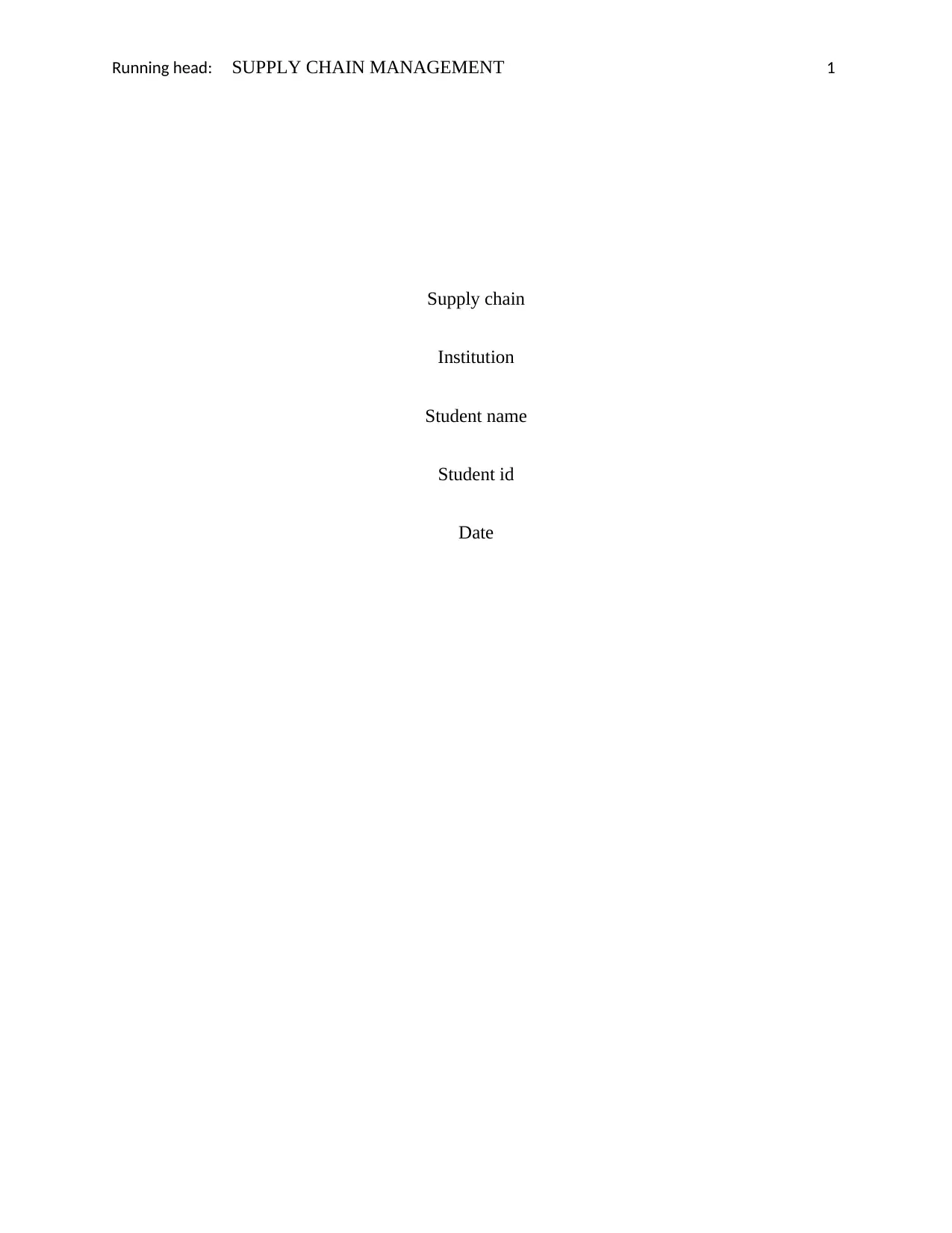
Running head: SUPPLY CHAIN MANAGEMENT 1
Supply chain
Institution
Student name
Student id
Date
Supply chain
Institution
Student name
Student id
Date
Secure Best Marks with AI Grader
Need help grading? Try our AI Grader for instant feedback on your assignments.
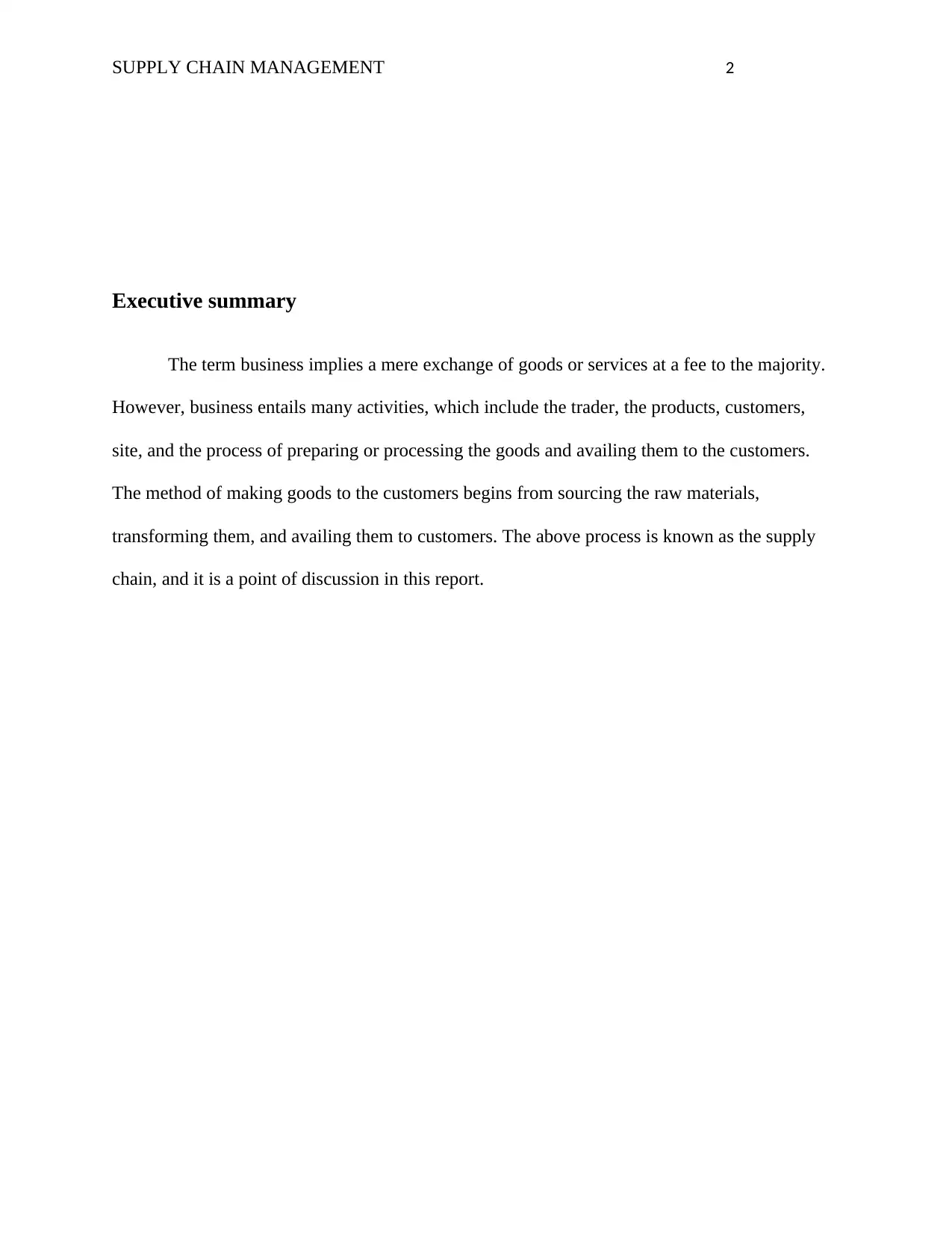
SUPPLY CHAIN MANAGEMENT 2
Executive summary
The term business implies a mere exchange of goods or services at a fee to the majority.
However, business entails many activities, which include the trader, the products, customers,
site, and the process of preparing or processing the goods and availing them to the customers.
The method of making goods to the customers begins from sourcing the raw materials,
transforming them, and availing them to customers. The above process is known as the supply
chain, and it is a point of discussion in this report.
Executive summary
The term business implies a mere exchange of goods or services at a fee to the majority.
However, business entails many activities, which include the trader, the products, customers,
site, and the process of preparing or processing the goods and availing them to the customers.
The method of making goods to the customers begins from sourcing the raw materials,
transforming them, and availing them to customers. The above process is known as the supply
chain, and it is a point of discussion in this report.
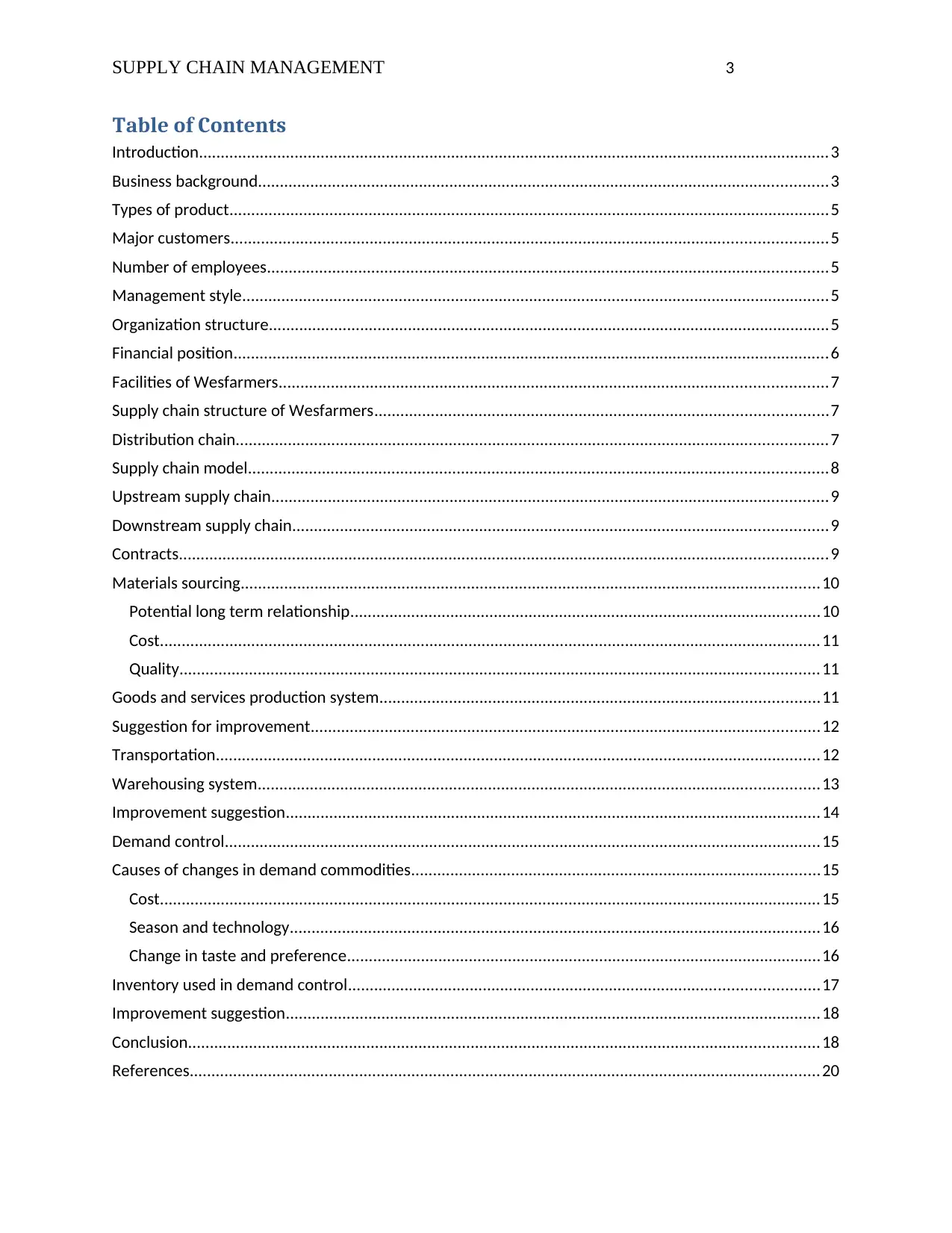
SUPPLY CHAIN MANAGEMENT 3
Table of Contents
Introduction.................................................................................................................................................3
Business background...................................................................................................................................3
Types of product..........................................................................................................................................5
Major customers.........................................................................................................................................5
Number of employees.................................................................................................................................5
Management style.......................................................................................................................................5
Organization structure.................................................................................................................................5
Financial position.........................................................................................................................................6
Facilities of Wesfarmers..............................................................................................................................7
Supply chain structure of Wesfarmers........................................................................................................7
Distribution chain........................................................................................................................................7
Supply chain model.....................................................................................................................................8
Upstream supply chain................................................................................................................................9
Downstream supply chain...........................................................................................................................9
Contracts.....................................................................................................................................................9
Materials sourcing.....................................................................................................................................10
Potential long term relationship............................................................................................................10
Cost........................................................................................................................................................11
Quality...................................................................................................................................................11
Goods and services production system.....................................................................................................11
Suggestion for improvement.....................................................................................................................12
Transportation...........................................................................................................................................12
Warehousing system.................................................................................................................................13
Improvement suggestion...........................................................................................................................14
Demand control.........................................................................................................................................15
Causes of changes in demand commodities..............................................................................................15
Cost........................................................................................................................................................15
Season and technology..........................................................................................................................16
Change in taste and preference.............................................................................................................16
Inventory used in demand control............................................................................................................17
Improvement suggestion...........................................................................................................................18
Conclusion.................................................................................................................................................18
References.................................................................................................................................................20
Table of Contents
Introduction.................................................................................................................................................3
Business background...................................................................................................................................3
Types of product..........................................................................................................................................5
Major customers.........................................................................................................................................5
Number of employees.................................................................................................................................5
Management style.......................................................................................................................................5
Organization structure.................................................................................................................................5
Financial position.........................................................................................................................................6
Facilities of Wesfarmers..............................................................................................................................7
Supply chain structure of Wesfarmers........................................................................................................7
Distribution chain........................................................................................................................................7
Supply chain model.....................................................................................................................................8
Upstream supply chain................................................................................................................................9
Downstream supply chain...........................................................................................................................9
Contracts.....................................................................................................................................................9
Materials sourcing.....................................................................................................................................10
Potential long term relationship............................................................................................................10
Cost........................................................................................................................................................11
Quality...................................................................................................................................................11
Goods and services production system.....................................................................................................11
Suggestion for improvement.....................................................................................................................12
Transportation...........................................................................................................................................12
Warehousing system.................................................................................................................................13
Improvement suggestion...........................................................................................................................14
Demand control.........................................................................................................................................15
Causes of changes in demand commodities..............................................................................................15
Cost........................................................................................................................................................15
Season and technology..........................................................................................................................16
Change in taste and preference.............................................................................................................16
Inventory used in demand control............................................................................................................17
Improvement suggestion...........................................................................................................................18
Conclusion.................................................................................................................................................18
References.................................................................................................................................................20
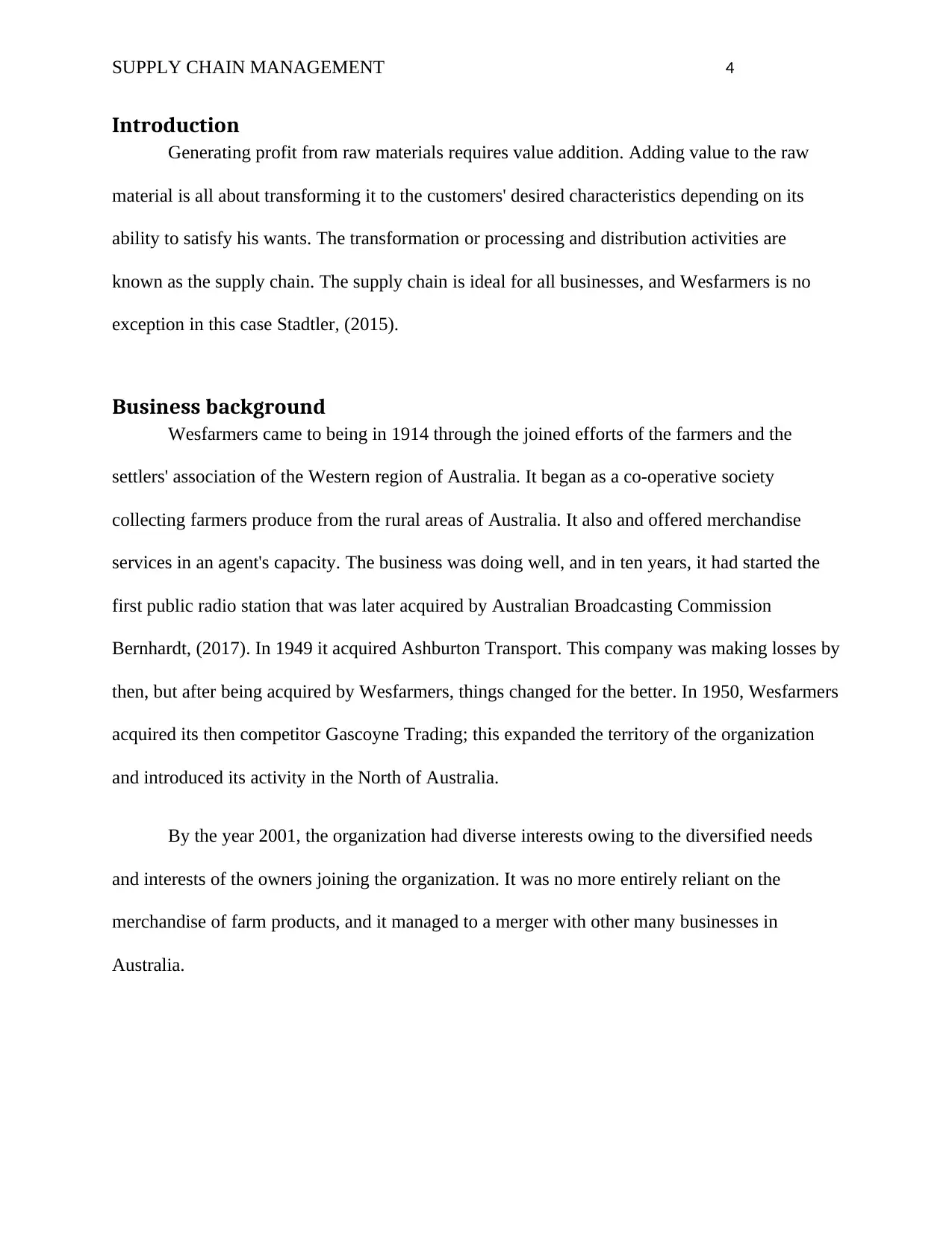
SUPPLY CHAIN MANAGEMENT 4
Introduction
Generating profit from raw materials requires value addition. Adding value to the raw
material is all about transforming it to the customers' desired characteristics depending on its
ability to satisfy his wants. The transformation or processing and distribution activities are
known as the supply chain. The supply chain is ideal for all businesses, and Wesfarmers is no
exception in this case Stadtler, (2015).
Business background
Wesfarmers came to being in 1914 through the joined efforts of the farmers and the
settlers' association of the Western region of Australia. It began as a co-operative society
collecting farmers produce from the rural areas of Australia. It also and offered merchandise
services in an agent's capacity. The business was doing well, and in ten years, it had started the
first public radio station that was later acquired by Australian Broadcasting Commission
Bernhardt, (2017). In 1949 it acquired Ashburton Transport. This company was making losses by
then, but after being acquired by Wesfarmers, things changed for the better. In 1950, Wesfarmers
acquired its then competitor Gascoyne Trading; this expanded the territory of the organization
and introduced its activity in the North of Australia.
By the year 2001, the organization had diverse interests owing to the diversified needs
and interests of the owners joining the organization. It was no more entirely reliant on the
merchandise of farm products, and it managed to a merger with other many businesses in
Australia.
Introduction
Generating profit from raw materials requires value addition. Adding value to the raw
material is all about transforming it to the customers' desired characteristics depending on its
ability to satisfy his wants. The transformation or processing and distribution activities are
known as the supply chain. The supply chain is ideal for all businesses, and Wesfarmers is no
exception in this case Stadtler, (2015).
Business background
Wesfarmers came to being in 1914 through the joined efforts of the farmers and the
settlers' association of the Western region of Australia. It began as a co-operative society
collecting farmers produce from the rural areas of Australia. It also and offered merchandise
services in an agent's capacity. The business was doing well, and in ten years, it had started the
first public radio station that was later acquired by Australian Broadcasting Commission
Bernhardt, (2017). In 1949 it acquired Ashburton Transport. This company was making losses by
then, but after being acquired by Wesfarmers, things changed for the better. In 1950, Wesfarmers
acquired its then competitor Gascoyne Trading; this expanded the territory of the organization
and introduced its activity in the North of Australia.
By the year 2001, the organization had diverse interests owing to the diversified needs
and interests of the owners joining the organization. It was no more entirely reliant on the
merchandise of farm products, and it managed to a merger with other many businesses in
Australia.
Secure Best Marks with AI Grader
Need help grading? Try our AI Grader for instant feedback on your assignments.
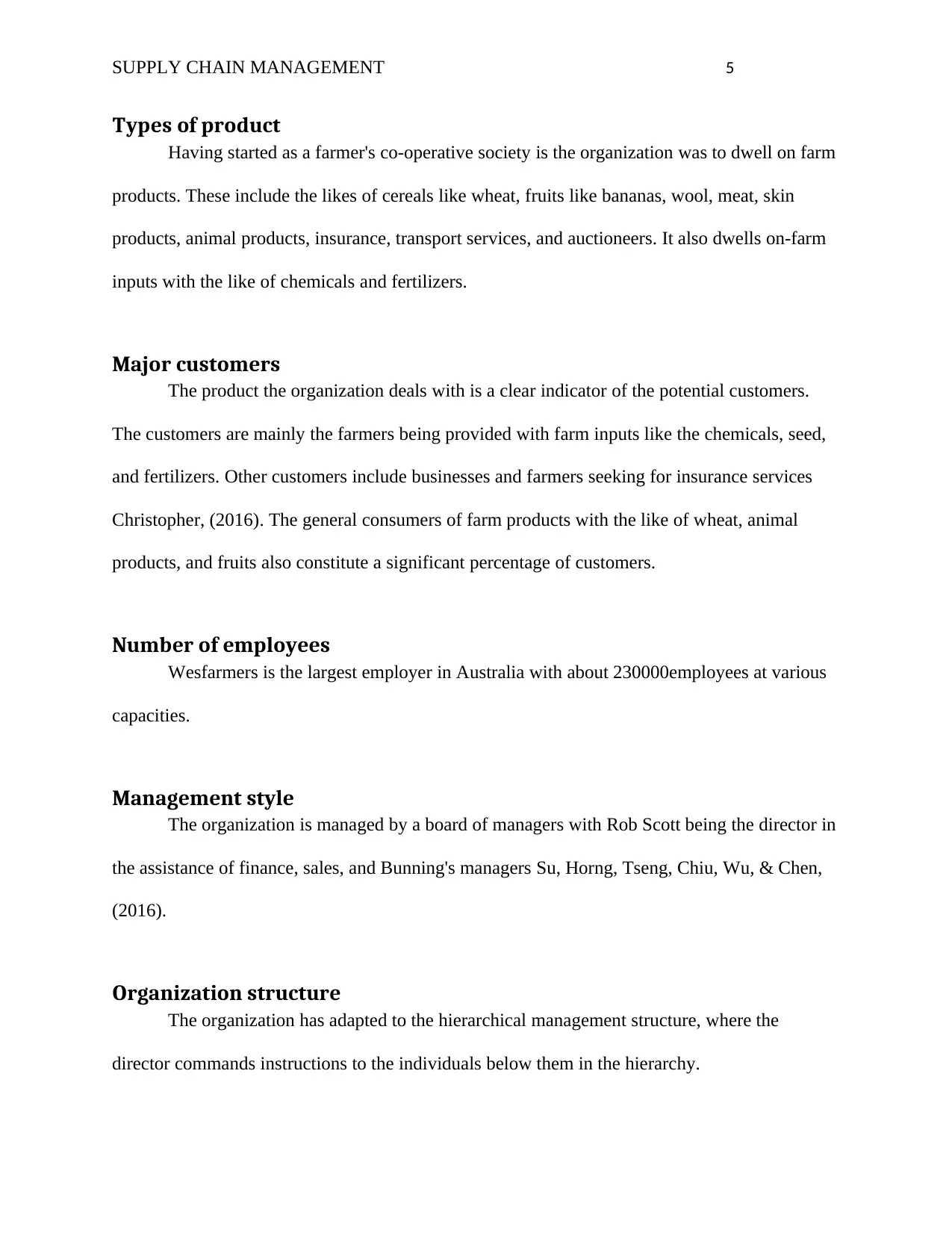
SUPPLY CHAIN MANAGEMENT 5
Types of product
Having started as a farmer's co-operative society is the organization was to dwell on farm
products. These include the likes of cereals like wheat, fruits like bananas, wool, meat, skin
products, animal products, insurance, transport services, and auctioneers. It also dwells on-farm
inputs with the like of chemicals and fertilizers.
Major customers
The product the organization deals with is a clear indicator of the potential customers.
The customers are mainly the farmers being provided with farm inputs like the chemicals, seed,
and fertilizers. Other customers include businesses and farmers seeking for insurance services
Christopher, (2016). The general consumers of farm products with the like of wheat, animal
products, and fruits also constitute a significant percentage of customers.
Number of employees
Wesfarmers is the largest employer in Australia with about 230000employees at various
capacities.
Management style
The organization is managed by a board of managers with Rob Scott being the director in
the assistance of finance, sales, and Bunning's managers Su, Horng, Tseng, Chiu, Wu, & Chen,
(2016).
Organization structure
The organization has adapted to the hierarchical management structure, where the
director commands instructions to the individuals below them in the hierarchy.
Types of product
Having started as a farmer's co-operative society is the organization was to dwell on farm
products. These include the likes of cereals like wheat, fruits like bananas, wool, meat, skin
products, animal products, insurance, transport services, and auctioneers. It also dwells on-farm
inputs with the like of chemicals and fertilizers.
Major customers
The product the organization deals with is a clear indicator of the potential customers.
The customers are mainly the farmers being provided with farm inputs like the chemicals, seed,
and fertilizers. Other customers include businesses and farmers seeking for insurance services
Christopher, (2016). The general consumers of farm products with the like of wheat, animal
products, and fruits also constitute a significant percentage of customers.
Number of employees
Wesfarmers is the largest employer in Australia with about 230000employees at various
capacities.
Management style
The organization is managed by a board of managers with Rob Scott being the director in
the assistance of finance, sales, and Bunning's managers Su, Horng, Tseng, Chiu, Wu, & Chen,
(2016).
Organization structure
The organization has adapted to the hierarchical management structure, where the
director commands instructions to the individuals below them in the hierarchy.
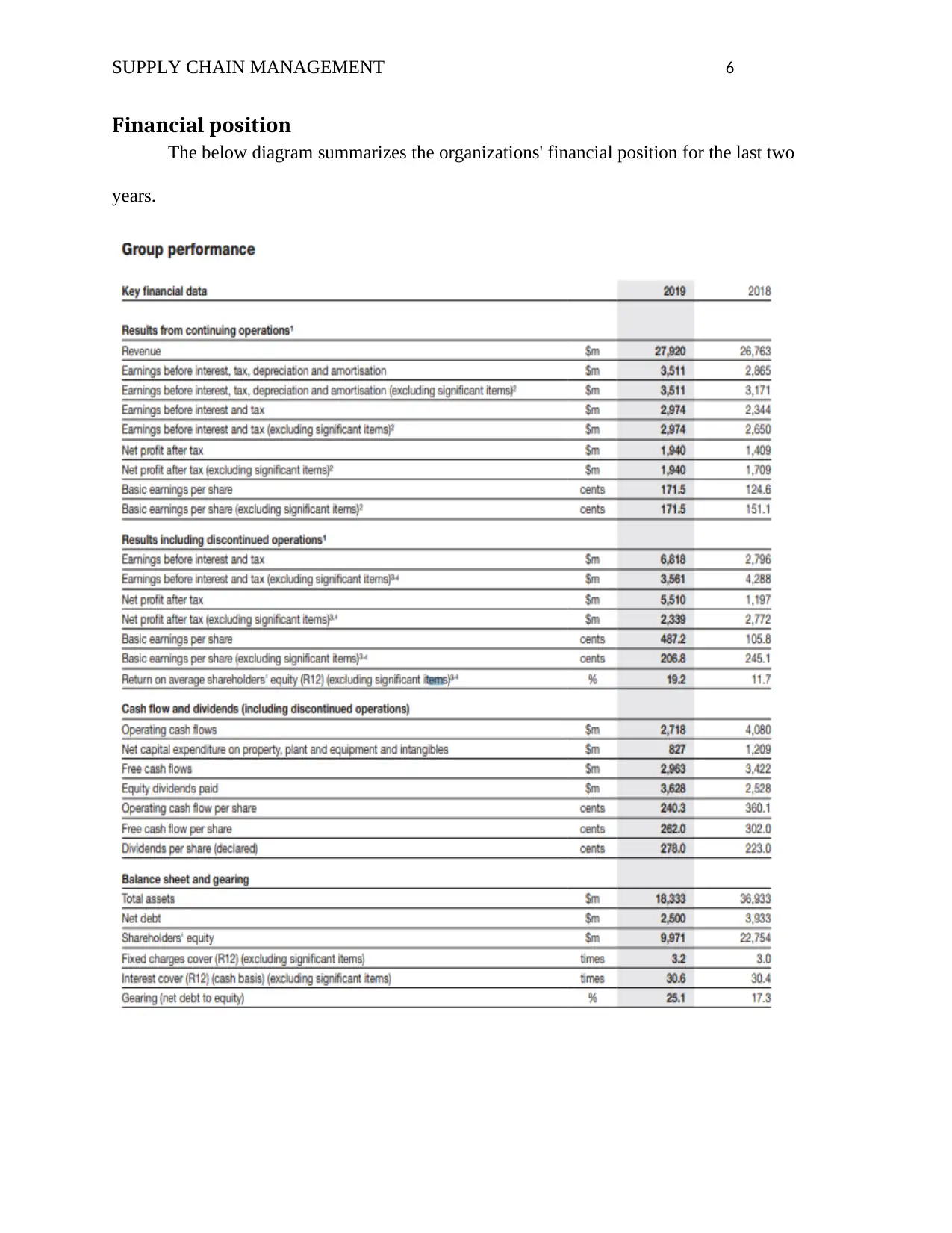
SUPPLY CHAIN MANAGEMENT 6
Financial position
The below diagram summarizes the organizations' financial position for the last two
years.
Financial position
The below diagram summarizes the organizations' financial position for the last two
years.
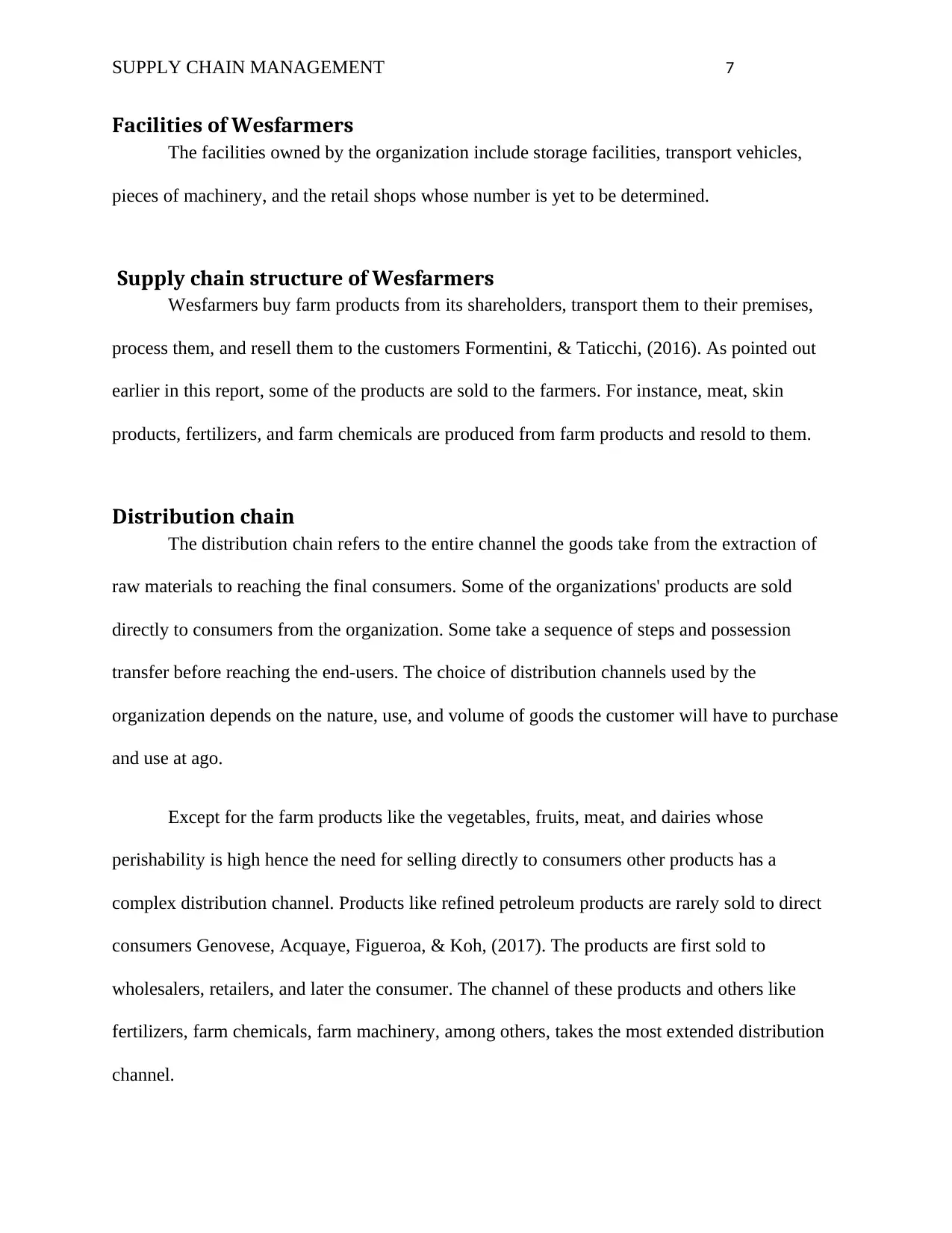
SUPPLY CHAIN MANAGEMENT 7
Facilities of Wesfarmers
The facilities owned by the organization include storage facilities, transport vehicles,
pieces of machinery, and the retail shops whose number is yet to be determined.
Supply chain structure of Wesfarmers
Wesfarmers buy farm products from its shareholders, transport them to their premises,
process them, and resell them to the customers Formentini, & Taticchi, (2016). As pointed out
earlier in this report, some of the products are sold to the farmers. For instance, meat, skin
products, fertilizers, and farm chemicals are produced from farm products and resold to them.
Distribution chain
The distribution chain refers to the entire channel the goods take from the extraction of
raw materials to reaching the final consumers. Some of the organizations' products are sold
directly to consumers from the organization. Some take a sequence of steps and possession
transfer before reaching the end-users. The choice of distribution channels used by the
organization depends on the nature, use, and volume of goods the customer will have to purchase
and use at ago.
Except for the farm products like the vegetables, fruits, meat, and dairies whose
perishability is high hence the need for selling directly to consumers other products has a
complex distribution channel. Products like refined petroleum products are rarely sold to direct
consumers Genovese, Acquaye, Figueroa, & Koh, (2017). The products are first sold to
wholesalers, retailers, and later the consumer. The channel of these products and others like
fertilizers, farm chemicals, farm machinery, among others, takes the most extended distribution
channel.
Facilities of Wesfarmers
The facilities owned by the organization include storage facilities, transport vehicles,
pieces of machinery, and the retail shops whose number is yet to be determined.
Supply chain structure of Wesfarmers
Wesfarmers buy farm products from its shareholders, transport them to their premises,
process them, and resell them to the customers Formentini, & Taticchi, (2016). As pointed out
earlier in this report, some of the products are sold to the farmers. For instance, meat, skin
products, fertilizers, and farm chemicals are produced from farm products and resold to them.
Distribution chain
The distribution chain refers to the entire channel the goods take from the extraction of
raw materials to reaching the final consumers. Some of the organizations' products are sold
directly to consumers from the organization. Some take a sequence of steps and possession
transfer before reaching the end-users. The choice of distribution channels used by the
organization depends on the nature, use, and volume of goods the customer will have to purchase
and use at ago.
Except for the farm products like the vegetables, fruits, meat, and dairies whose
perishability is high hence the need for selling directly to consumers other products has a
complex distribution channel. Products like refined petroleum products are rarely sold to direct
consumers Genovese, Acquaye, Figueroa, & Koh, (2017). The products are first sold to
wholesalers, retailers, and later the consumer. The channel of these products and others like
fertilizers, farm chemicals, farm machinery, among others, takes the most extended distribution
channel.
Paraphrase This Document
Need a fresh take? Get an instant paraphrase of this document with our AI Paraphraser
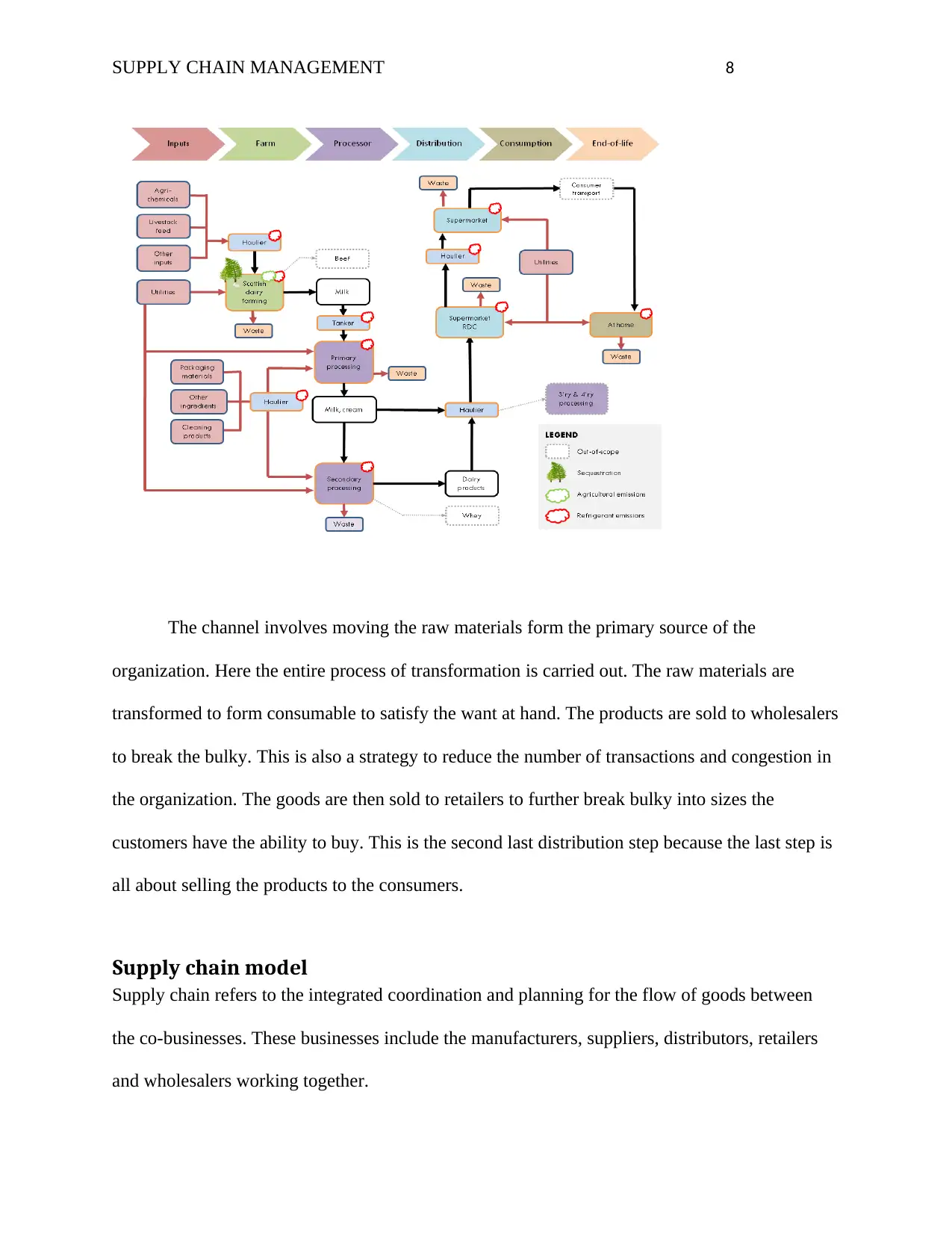
SUPPLY CHAIN MANAGEMENT 8
The channel involves moving the raw materials form the primary source of the
organization. Here the entire process of transformation is carried out. The raw materials are
transformed to form consumable to satisfy the want at hand. The products are sold to wholesalers
to break the bulky. This is also a strategy to reduce the number of transactions and congestion in
the organization. The goods are then sold to retailers to further break bulky into sizes the
customers have the ability to buy. This is the second last distribution step because the last step is
all about selling the products to the consumers.
Supply chain model
Supply chain refers to the integrated coordination and planning for the flow of goods between
the co-businesses. These businesses include the manufacturers, suppliers, distributors, retailers
and wholesalers working together.
The channel involves moving the raw materials form the primary source of the
organization. Here the entire process of transformation is carried out. The raw materials are
transformed to form consumable to satisfy the want at hand. The products are sold to wholesalers
to break the bulky. This is also a strategy to reduce the number of transactions and congestion in
the organization. The goods are then sold to retailers to further break bulky into sizes the
customers have the ability to buy. This is the second last distribution step because the last step is
all about selling the products to the consumers.
Supply chain model
Supply chain refers to the integrated coordination and planning for the flow of goods between
the co-businesses. These businesses include the manufacturers, suppliers, distributors, retailers
and wholesalers working together.
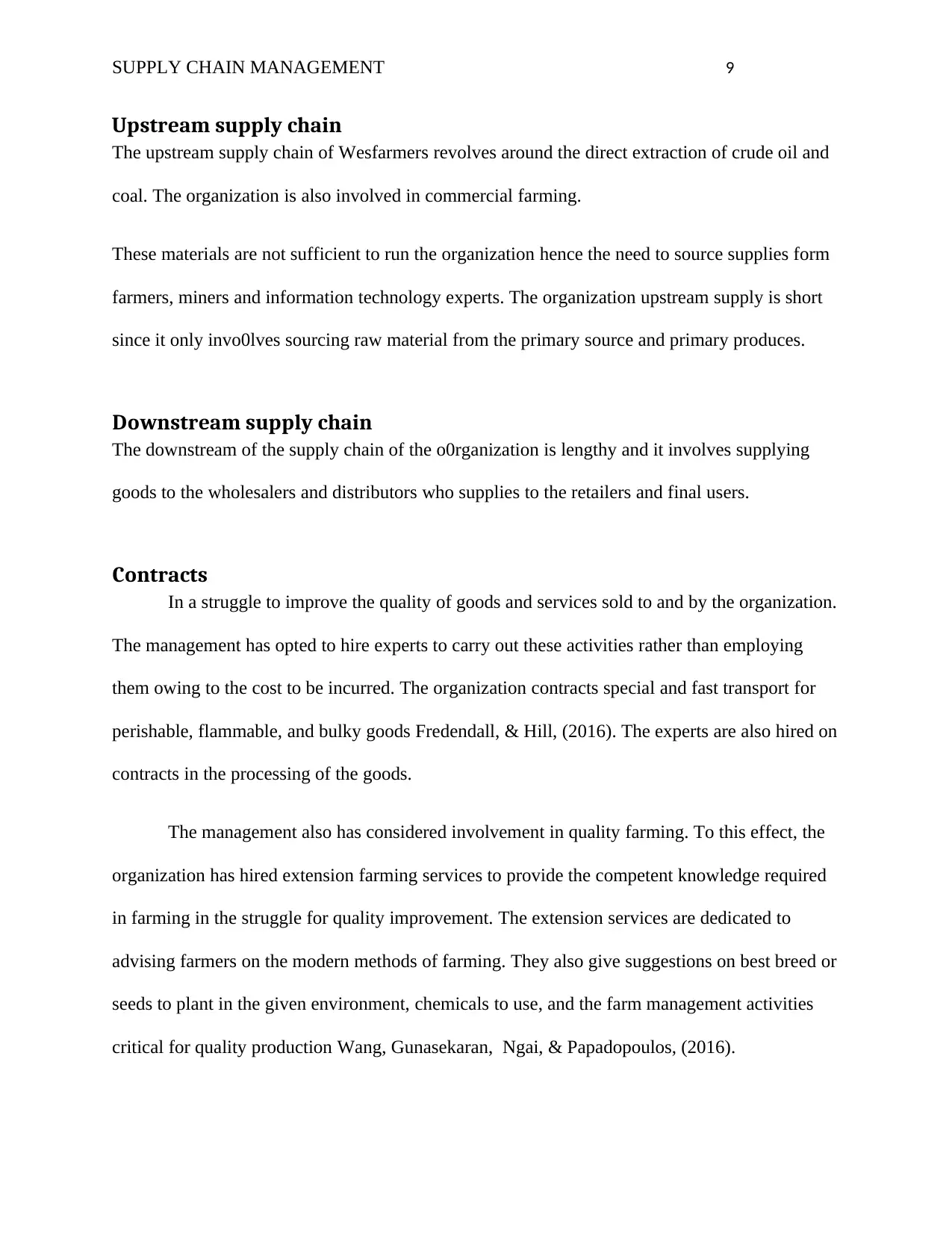
SUPPLY CHAIN MANAGEMENT 9
Upstream supply chain
The upstream supply chain of Wesfarmers revolves around the direct extraction of crude oil and
coal. The organization is also involved in commercial farming.
These materials are not sufficient to run the organization hence the need to source supplies form
farmers, miners and information technology experts. The organization upstream supply is short
since it only invo0lves sourcing raw material from the primary source and primary produces.
Downstream supply chain
The downstream of the supply chain of the o0rganization is lengthy and it involves supplying
goods to the wholesalers and distributors who supplies to the retailers and final users.
Contracts
In a struggle to improve the quality of goods and services sold to and by the organization.
The management has opted to hire experts to carry out these activities rather than employing
them owing to the cost to be incurred. The organization contracts special and fast transport for
perishable, flammable, and bulky goods Fredendall, & Hill, (2016). The experts are also hired on
contracts in the processing of the goods.
The management also has considered involvement in quality farming. To this effect, the
organization has hired extension farming services to provide the competent knowledge required
in farming in the struggle for quality improvement. The extension services are dedicated to
advising farmers on the modern methods of farming. They also give suggestions on best breed or
seeds to plant in the given environment, chemicals to use, and the farm management activities
critical for quality production Wang, Gunasekaran, Ngai, & Papadopoulos, (2016).
Upstream supply chain
The upstream supply chain of Wesfarmers revolves around the direct extraction of crude oil and
coal. The organization is also involved in commercial farming.
These materials are not sufficient to run the organization hence the need to source supplies form
farmers, miners and information technology experts. The organization upstream supply is short
since it only invo0lves sourcing raw material from the primary source and primary produces.
Downstream supply chain
The downstream of the supply chain of the o0rganization is lengthy and it involves supplying
goods to the wholesalers and distributors who supplies to the retailers and final users.
Contracts
In a struggle to improve the quality of goods and services sold to and by the organization.
The management has opted to hire experts to carry out these activities rather than employing
them owing to the cost to be incurred. The organization contracts special and fast transport for
perishable, flammable, and bulky goods Fredendall, & Hill, (2016). The experts are also hired on
contracts in the processing of the goods.
The management also has considered involvement in quality farming. To this effect, the
organization has hired extension farming services to provide the competent knowledge required
in farming in the struggle for quality improvement. The extension services are dedicated to
advising farmers on the modern methods of farming. They also give suggestions on best breed or
seeds to plant in the given environment, chemicals to use, and the farm management activities
critical for quality production Wang, Gunasekaran, Ngai, & Papadopoulos, (2016).
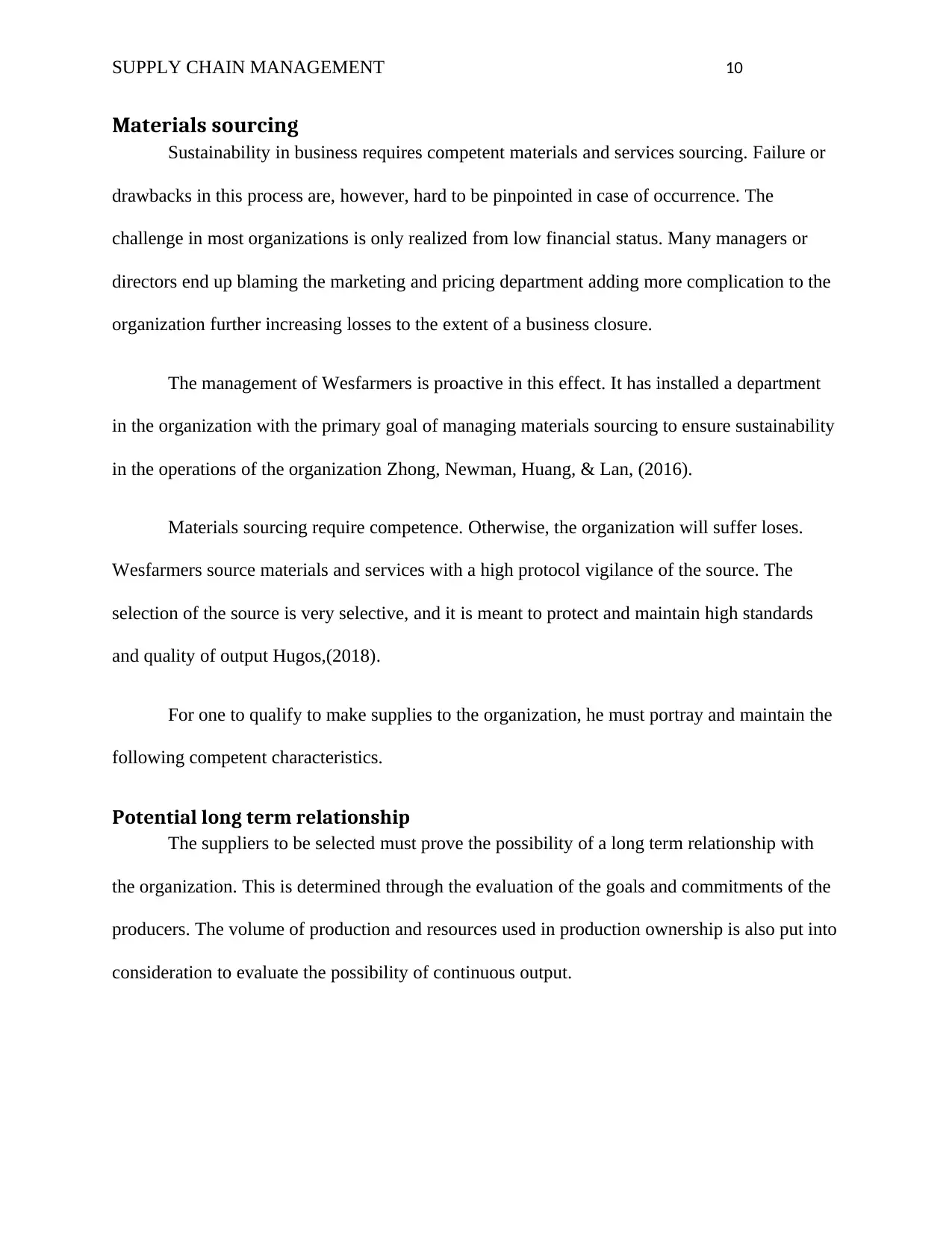
SUPPLY CHAIN MANAGEMENT 10
Materials sourcing
Sustainability in business requires competent materials and services sourcing. Failure or
drawbacks in this process are, however, hard to be pinpointed in case of occurrence. The
challenge in most organizations is only realized from low financial status. Many managers or
directors end up blaming the marketing and pricing department adding more complication to the
organization further increasing losses to the extent of a business closure.
The management of Wesfarmers is proactive in this effect. It has installed a department
in the organization with the primary goal of managing materials sourcing to ensure sustainability
in the operations of the organization Zhong, Newman, Huang, & Lan, (2016).
Materials sourcing require competence. Otherwise, the organization will suffer loses.
Wesfarmers source materials and services with a high protocol vigilance of the source. The
selection of the source is very selective, and it is meant to protect and maintain high standards
and quality of output Hugos,(2018).
For one to qualify to make supplies to the organization, he must portray and maintain the
following competent characteristics.
Potential long term relationship
The suppliers to be selected must prove the possibility of a long term relationship with
the organization. This is determined through the evaluation of the goals and commitments of the
producers. The volume of production and resources used in production ownership is also put into
consideration to evaluate the possibility of continuous output.
Materials sourcing
Sustainability in business requires competent materials and services sourcing. Failure or
drawbacks in this process are, however, hard to be pinpointed in case of occurrence. The
challenge in most organizations is only realized from low financial status. Many managers or
directors end up blaming the marketing and pricing department adding more complication to the
organization further increasing losses to the extent of a business closure.
The management of Wesfarmers is proactive in this effect. It has installed a department
in the organization with the primary goal of managing materials sourcing to ensure sustainability
in the operations of the organization Zhong, Newman, Huang, & Lan, (2016).
Materials sourcing require competence. Otherwise, the organization will suffer loses.
Wesfarmers source materials and services with a high protocol vigilance of the source. The
selection of the source is very selective, and it is meant to protect and maintain high standards
and quality of output Hugos,(2018).
For one to qualify to make supplies to the organization, he must portray and maintain the
following competent characteristics.
Potential long term relationship
The suppliers to be selected must prove the possibility of a long term relationship with
the organization. This is determined through the evaluation of the goals and commitments of the
producers. The volume of production and resources used in production ownership is also put into
consideration to evaluate the possibility of continuous output.
Secure Best Marks with AI Grader
Need help grading? Try our AI Grader for instant feedback on your assignments.
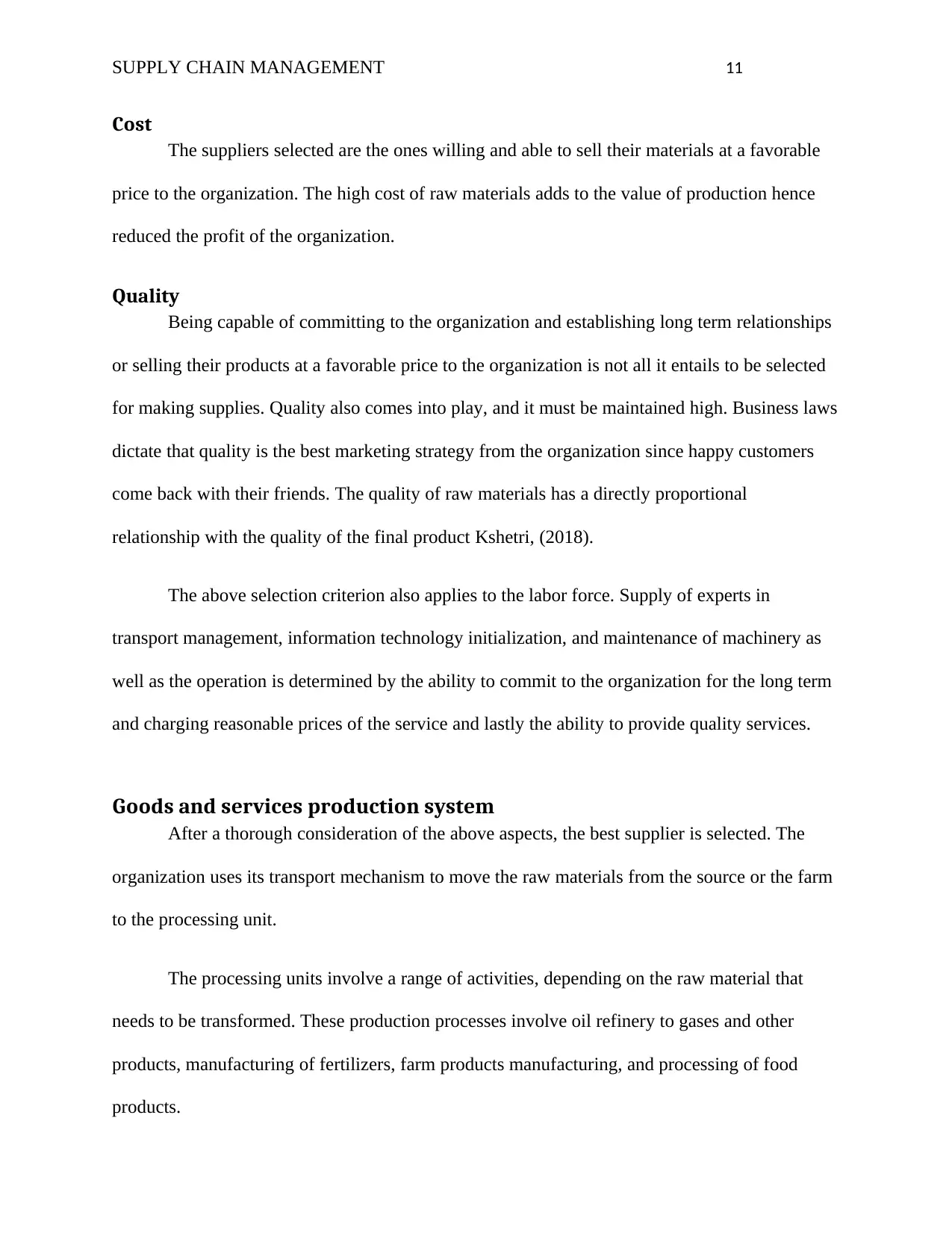
SUPPLY CHAIN MANAGEMENT 11
Cost
The suppliers selected are the ones willing and able to sell their materials at a favorable
price to the organization. The high cost of raw materials adds to the value of production hence
reduced the profit of the organization.
Quality
Being capable of committing to the organization and establishing long term relationships
or selling their products at a favorable price to the organization is not all it entails to be selected
for making supplies. Quality also comes into play, and it must be maintained high. Business laws
dictate that quality is the best marketing strategy from the organization since happy customers
come back with their friends. The quality of raw materials has a directly proportional
relationship with the quality of the final product Kshetri, (2018).
The above selection criterion also applies to the labor force. Supply of experts in
transport management, information technology initialization, and maintenance of machinery as
well as the operation is determined by the ability to commit to the organization for the long term
and charging reasonable prices of the service and lastly the ability to provide quality services.
Goods and services production system
After a thorough consideration of the above aspects, the best supplier is selected. The
organization uses its transport mechanism to move the raw materials from the source or the farm
to the processing unit.
The processing units involve a range of activities, depending on the raw material that
needs to be transformed. These production processes involve oil refinery to gases and other
products, manufacturing of fertilizers, farm products manufacturing, and processing of food
products.
Cost
The suppliers selected are the ones willing and able to sell their materials at a favorable
price to the organization. The high cost of raw materials adds to the value of production hence
reduced the profit of the organization.
Quality
Being capable of committing to the organization and establishing long term relationships
or selling their products at a favorable price to the organization is not all it entails to be selected
for making supplies. Quality also comes into play, and it must be maintained high. Business laws
dictate that quality is the best marketing strategy from the organization since happy customers
come back with their friends. The quality of raw materials has a directly proportional
relationship with the quality of the final product Kshetri, (2018).
The above selection criterion also applies to the labor force. Supply of experts in
transport management, information technology initialization, and maintenance of machinery as
well as the operation is determined by the ability to commit to the organization for the long term
and charging reasonable prices of the service and lastly the ability to provide quality services.
Goods and services production system
After a thorough consideration of the above aspects, the best supplier is selected. The
organization uses its transport mechanism to move the raw materials from the source or the farm
to the processing unit.
The processing units involve a range of activities, depending on the raw material that
needs to be transformed. These production processes involve oil refinery to gases and other
products, manufacturing of fertilizers, farm products manufacturing, and processing of food
products.
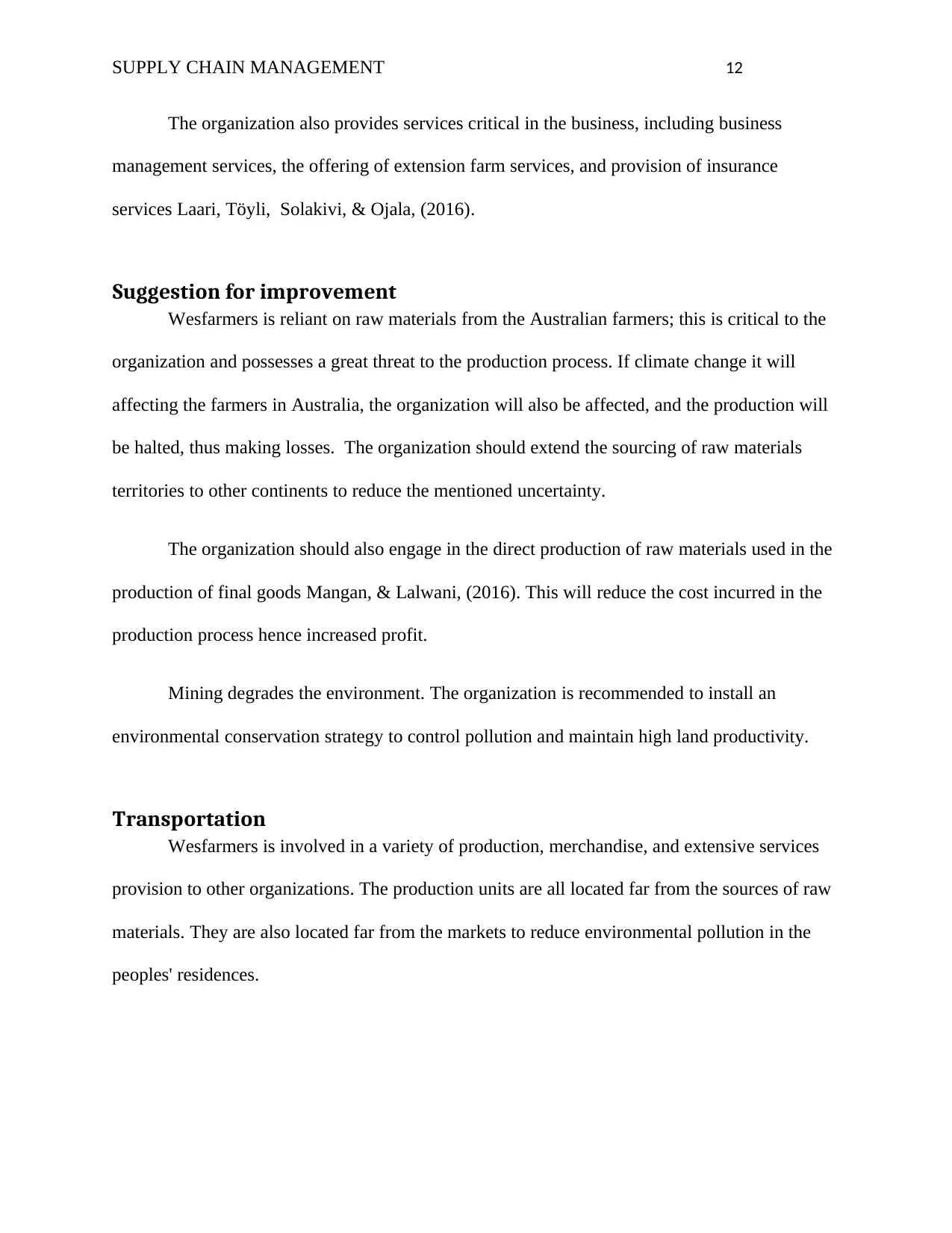
SUPPLY CHAIN MANAGEMENT 12
The organization also provides services critical in the business, including business
management services, the offering of extension farm services, and provision of insurance
services Laari, Töyli, Solakivi, & Ojala, (2016).
Suggestion for improvement
Wesfarmers is reliant on raw materials from the Australian farmers; this is critical to the
organization and possesses a great threat to the production process. If climate change it will
affecting the farmers in Australia, the organization will also be affected, and the production will
be halted, thus making losses. The organization should extend the sourcing of raw materials
territories to other continents to reduce the mentioned uncertainty.
The organization should also engage in the direct production of raw materials used in the
production of final goods Mangan, & Lalwani, (2016). This will reduce the cost incurred in the
production process hence increased profit.
Mining degrades the environment. The organization is recommended to install an
environmental conservation strategy to control pollution and maintain high land productivity.
Transportation
Wesfarmers is involved in a variety of production, merchandise, and extensive services
provision to other organizations. The production units are all located far from the sources of raw
materials. They are also located far from the markets to reduce environmental pollution in the
peoples' residences.
The organization also provides services critical in the business, including business
management services, the offering of extension farm services, and provision of insurance
services Laari, Töyli, Solakivi, & Ojala, (2016).
Suggestion for improvement
Wesfarmers is reliant on raw materials from the Australian farmers; this is critical to the
organization and possesses a great threat to the production process. If climate change it will
affecting the farmers in Australia, the organization will also be affected, and the production will
be halted, thus making losses. The organization should extend the sourcing of raw materials
territories to other continents to reduce the mentioned uncertainty.
The organization should also engage in the direct production of raw materials used in the
production of final goods Mangan, & Lalwani, (2016). This will reduce the cost incurred in the
production process hence increased profit.
Mining degrades the environment. The organization is recommended to install an
environmental conservation strategy to control pollution and maintain high land productivity.
Transportation
Wesfarmers is involved in a variety of production, merchandise, and extensive services
provision to other organizations. The production units are all located far from the sources of raw
materials. They are also located far from the markets to reduce environmental pollution in the
peoples' residences.
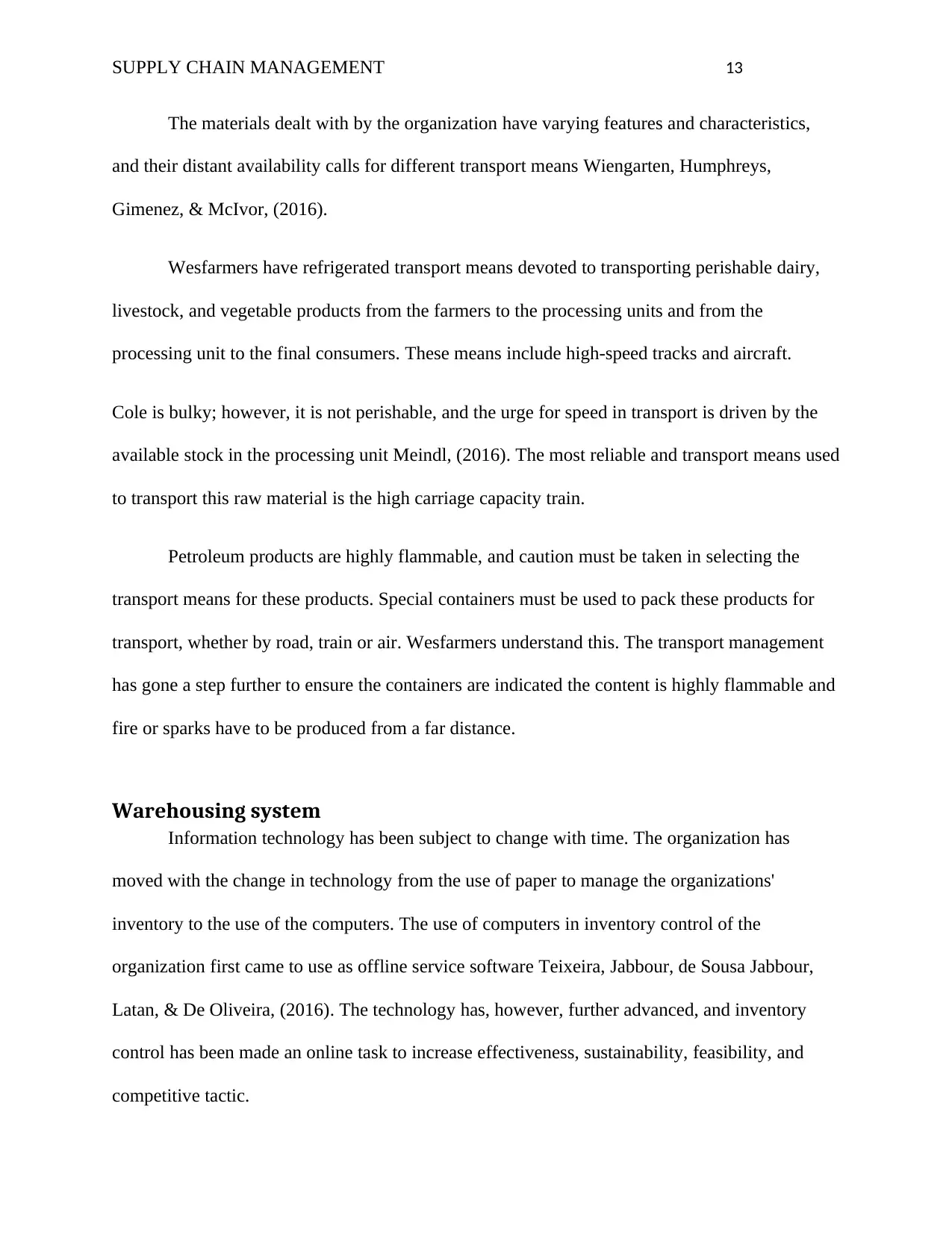
SUPPLY CHAIN MANAGEMENT 13
The materials dealt with by the organization have varying features and characteristics,
and their distant availability calls for different transport means Wiengarten, Humphreys,
Gimenez, & McIvor, (2016).
Wesfarmers have refrigerated transport means devoted to transporting perishable dairy,
livestock, and vegetable products from the farmers to the processing units and from the
processing unit to the final consumers. These means include high-speed tracks and aircraft.
Cole is bulky; however, it is not perishable, and the urge for speed in transport is driven by the
available stock in the processing unit Meindl, (2016). The most reliable and transport means used
to transport this raw material is the high carriage capacity train.
Petroleum products are highly flammable, and caution must be taken in selecting the
transport means for these products. Special containers must be used to pack these products for
transport, whether by road, train or air. Wesfarmers understand this. The transport management
has gone a step further to ensure the containers are indicated the content is highly flammable and
fire or sparks have to be produced from a far distance.
Warehousing system
Information technology has been subject to change with time. The organization has
moved with the change in technology from the use of paper to manage the organizations'
inventory to the use of the computers. The use of computers in inventory control of the
organization first came to use as offline service software Teixeira, Jabbour, de Sousa Jabbour,
Latan, & De Oliveira, (2016). The technology has, however, further advanced, and inventory
control has been made an online task to increase effectiveness, sustainability, feasibility, and
competitive tactic.
The materials dealt with by the organization have varying features and characteristics,
and their distant availability calls for different transport means Wiengarten, Humphreys,
Gimenez, & McIvor, (2016).
Wesfarmers have refrigerated transport means devoted to transporting perishable dairy,
livestock, and vegetable products from the farmers to the processing units and from the
processing unit to the final consumers. These means include high-speed tracks and aircraft.
Cole is bulky; however, it is not perishable, and the urge for speed in transport is driven by the
available stock in the processing unit Meindl, (2016). The most reliable and transport means used
to transport this raw material is the high carriage capacity train.
Petroleum products are highly flammable, and caution must be taken in selecting the
transport means for these products. Special containers must be used to pack these products for
transport, whether by road, train or air. Wesfarmers understand this. The transport management
has gone a step further to ensure the containers are indicated the content is highly flammable and
fire or sparks have to be produced from a far distance.
Warehousing system
Information technology has been subject to change with time. The organization has
moved with the change in technology from the use of paper to manage the organizations'
inventory to the use of the computers. The use of computers in inventory control of the
organization first came to use as offline service software Teixeira, Jabbour, de Sousa Jabbour,
Latan, & De Oliveira, (2016). The technology has, however, further advanced, and inventory
control has been made an online task to increase effectiveness, sustainability, feasibility, and
competitive tactic.
Paraphrase This Document
Need a fresh take? Get an instant paraphrase of this document with our AI Paraphraser
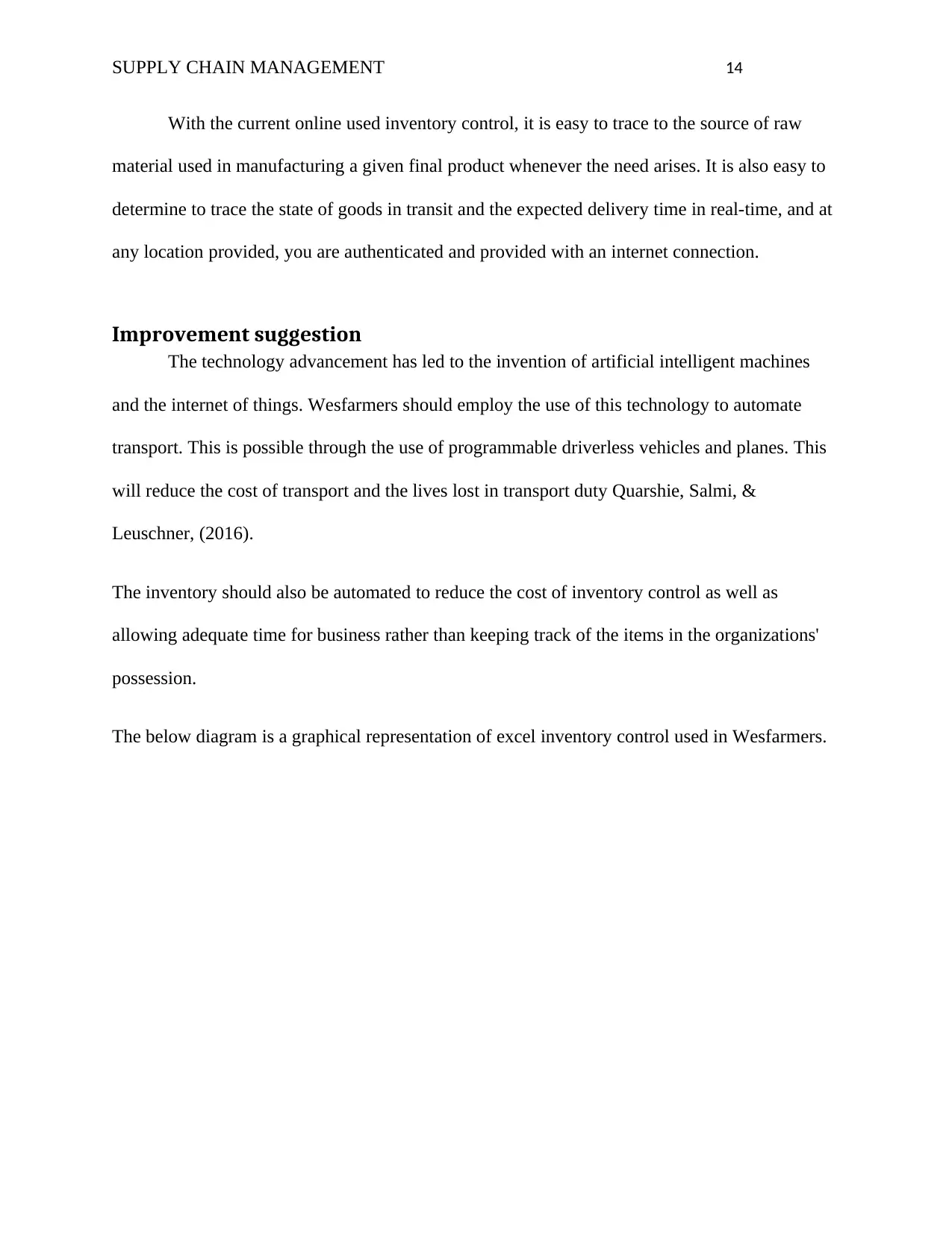
SUPPLY CHAIN MANAGEMENT 14
With the current online used inventory control, it is easy to trace to the source of raw
material used in manufacturing a given final product whenever the need arises. It is also easy to
determine to trace the state of goods in transit and the expected delivery time in real-time, and at
any location provided, you are authenticated and provided with an internet connection.
Improvement suggestion
The technology advancement has led to the invention of artificial intelligent machines
and the internet of things. Wesfarmers should employ the use of this technology to automate
transport. This is possible through the use of programmable driverless vehicles and planes. This
will reduce the cost of transport and the lives lost in transport duty Quarshie, Salmi, &
Leuschner, (2016).
The inventory should also be automated to reduce the cost of inventory control as well as
allowing adequate time for business rather than keeping track of the items in the organizations'
possession.
The below diagram is a graphical representation of excel inventory control used in Wesfarmers.
With the current online used inventory control, it is easy to trace to the source of raw
material used in manufacturing a given final product whenever the need arises. It is also easy to
determine to trace the state of goods in transit and the expected delivery time in real-time, and at
any location provided, you are authenticated and provided with an internet connection.
Improvement suggestion
The technology advancement has led to the invention of artificial intelligent machines
and the internet of things. Wesfarmers should employ the use of this technology to automate
transport. This is possible through the use of programmable driverless vehicles and planes. This
will reduce the cost of transport and the lives lost in transport duty Quarshie, Salmi, &
Leuschner, (2016).
The inventory should also be automated to reduce the cost of inventory control as well as
allowing adequate time for business rather than keeping track of the items in the organizations'
possession.
The below diagram is a graphical representation of excel inventory control used in Wesfarmers.
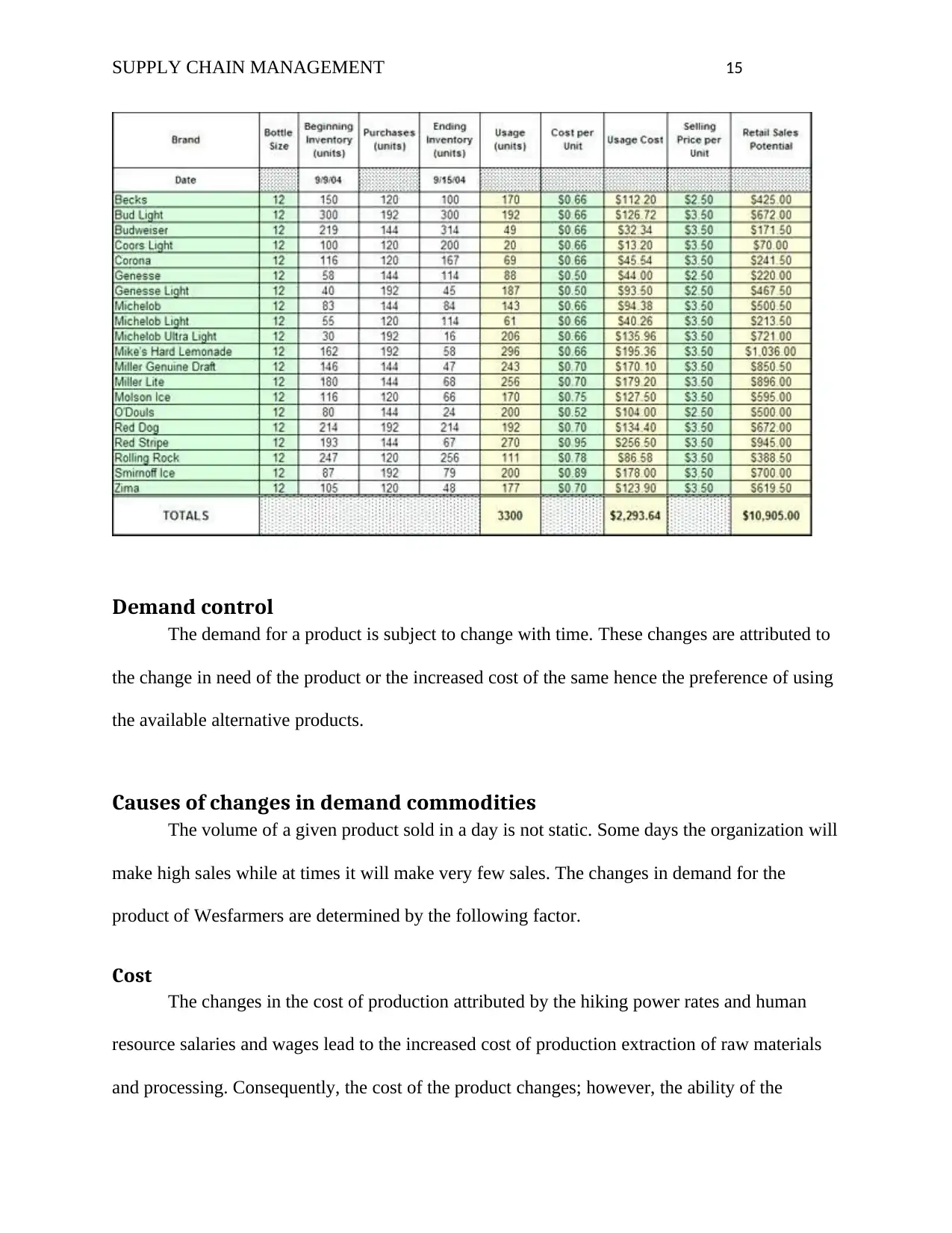
SUPPLY CHAIN MANAGEMENT 15
Demand control
The demand for a product is subject to change with time. These changes are attributed to
the change in need of the product or the increased cost of the same hence the preference of using
the available alternative products.
Causes of changes in demand commodities
The volume of a given product sold in a day is not static. Some days the organization will
make high sales while at times it will make very few sales. The changes in demand for the
product of Wesfarmers are determined by the following factor.
Cost
The changes in the cost of production attributed by the hiking power rates and human
resource salaries and wages lead to the increased cost of production extraction of raw materials
and processing. Consequently, the cost of the product changes; however, the ability of the
Demand control
The demand for a product is subject to change with time. These changes are attributed to
the change in need of the product or the increased cost of the same hence the preference of using
the available alternative products.
Causes of changes in demand commodities
The volume of a given product sold in a day is not static. Some days the organization will
make high sales while at times it will make very few sales. The changes in demand for the
product of Wesfarmers are determined by the following factor.
Cost
The changes in the cost of production attributed by the hiking power rates and human
resource salaries and wages lead to the increased cost of production extraction of raw materials
and processing. Consequently, the cost of the product changes; however, the ability of the
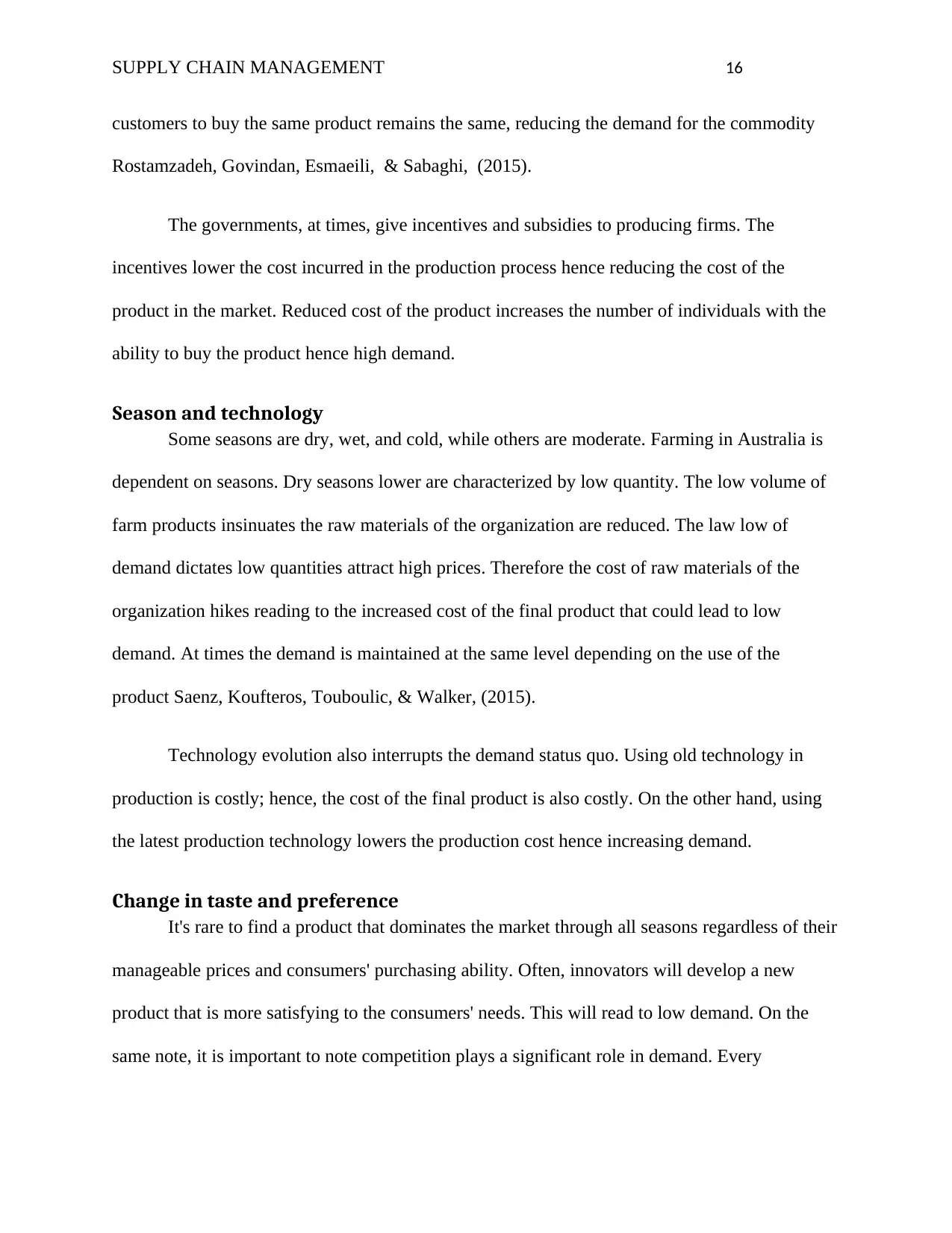
SUPPLY CHAIN MANAGEMENT 16
customers to buy the same product remains the same, reducing the demand for the commodity
Rostamzadeh, Govindan, Esmaeili, & Sabaghi, (2015).
The governments, at times, give incentives and subsidies to producing firms. The
incentives lower the cost incurred in the production process hence reducing the cost of the
product in the market. Reduced cost of the product increases the number of individuals with the
ability to buy the product hence high demand.
Season and technology
Some seasons are dry, wet, and cold, while others are moderate. Farming in Australia is
dependent on seasons. Dry seasons lower are characterized by low quantity. The low volume of
farm products insinuates the raw materials of the organization are reduced. The law low of
demand dictates low quantities attract high prices. Therefore the cost of raw materials of the
organization hikes reading to the increased cost of the final product that could lead to low
demand. At times the demand is maintained at the same level depending on the use of the
product Saenz, Koufteros, Touboulic, & Walker, (2015).
Technology evolution also interrupts the demand status quo. Using old technology in
production is costly; hence, the cost of the final product is also costly. On the other hand, using
the latest production technology lowers the production cost hence increasing demand.
Change in taste and preference
It's rare to find a product that dominates the market through all seasons regardless of their
manageable prices and consumers' purchasing ability. Often, innovators will develop a new
product that is more satisfying to the consumers' needs. This will read to low demand. On the
same note, it is important to note competition plays a significant role in demand. Every
customers to buy the same product remains the same, reducing the demand for the commodity
Rostamzadeh, Govindan, Esmaeili, & Sabaghi, (2015).
The governments, at times, give incentives and subsidies to producing firms. The
incentives lower the cost incurred in the production process hence reducing the cost of the
product in the market. Reduced cost of the product increases the number of individuals with the
ability to buy the product hence high demand.
Season and technology
Some seasons are dry, wet, and cold, while others are moderate. Farming in Australia is
dependent on seasons. Dry seasons lower are characterized by low quantity. The low volume of
farm products insinuates the raw materials of the organization are reduced. The law low of
demand dictates low quantities attract high prices. Therefore the cost of raw materials of the
organization hikes reading to the increased cost of the final product that could lead to low
demand. At times the demand is maintained at the same level depending on the use of the
product Saenz, Koufteros, Touboulic, & Walker, (2015).
Technology evolution also interrupts the demand status quo. Using old technology in
production is costly; hence, the cost of the final product is also costly. On the other hand, using
the latest production technology lowers the production cost hence increasing demand.
Change in taste and preference
It's rare to find a product that dominates the market through all seasons regardless of their
manageable prices and consumers' purchasing ability. Often, innovators will develop a new
product that is more satisfying to the consumers' needs. This will read to low demand. On the
same note, it is important to note competition plays a significant role in demand. Every
Secure Best Marks with AI Grader
Need help grading? Try our AI Grader for instant feedback on your assignments.
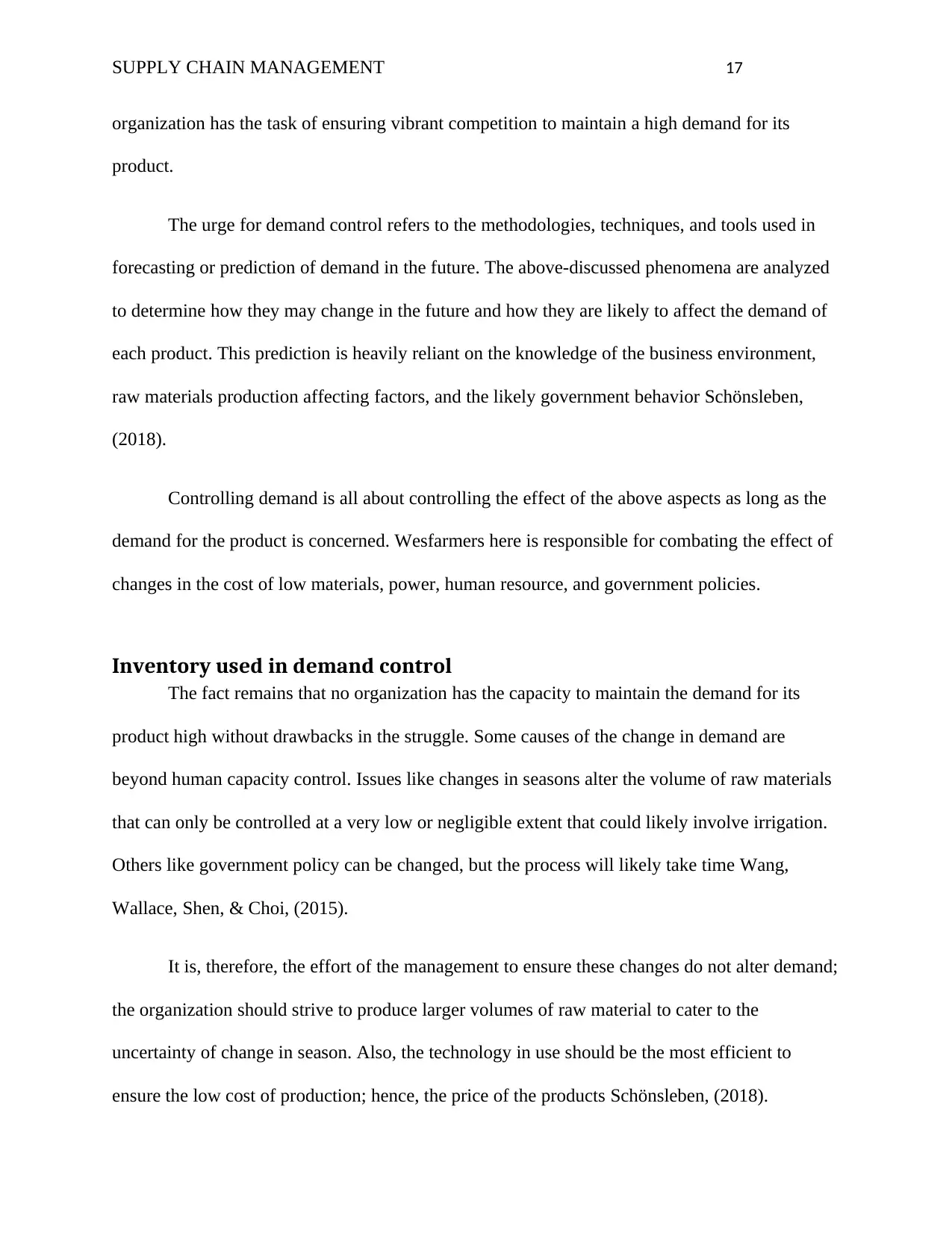
SUPPLY CHAIN MANAGEMENT 17
organization has the task of ensuring vibrant competition to maintain a high demand for its
product.
The urge for demand control refers to the methodologies, techniques, and tools used in
forecasting or prediction of demand in the future. The above-discussed phenomena are analyzed
to determine how they may change in the future and how they are likely to affect the demand of
each product. This prediction is heavily reliant on the knowledge of the business environment,
raw materials production affecting factors, and the likely government behavior Schönsleben,
(2018).
Controlling demand is all about controlling the effect of the above aspects as long as the
demand for the product is concerned. Wesfarmers here is responsible for combating the effect of
changes in the cost of low materials, power, human resource, and government policies.
Inventory used in demand control
The fact remains that no organization has the capacity to maintain the demand for its
product high without drawbacks in the struggle. Some causes of the change in demand are
beyond human capacity control. Issues like changes in seasons alter the volume of raw materials
that can only be controlled at a very low or negligible extent that could likely involve irrigation.
Others like government policy can be changed, but the process will likely take time Wang,
Wallace, Shen, & Choi, (2015).
It is, therefore, the effort of the management to ensure these changes do not alter demand;
the organization should strive to produce larger volumes of raw material to cater to the
uncertainty of change in season. Also, the technology in use should be the most efficient to
ensure the low cost of production; hence, the price of the products Schönsleben, (2018).
organization has the task of ensuring vibrant competition to maintain a high demand for its
product.
The urge for demand control refers to the methodologies, techniques, and tools used in
forecasting or prediction of demand in the future. The above-discussed phenomena are analyzed
to determine how they may change in the future and how they are likely to affect the demand of
each product. This prediction is heavily reliant on the knowledge of the business environment,
raw materials production affecting factors, and the likely government behavior Schönsleben,
(2018).
Controlling demand is all about controlling the effect of the above aspects as long as the
demand for the product is concerned. Wesfarmers here is responsible for combating the effect of
changes in the cost of low materials, power, human resource, and government policies.
Inventory used in demand control
The fact remains that no organization has the capacity to maintain the demand for its
product high without drawbacks in the struggle. Some causes of the change in demand are
beyond human capacity control. Issues like changes in seasons alter the volume of raw materials
that can only be controlled at a very low or negligible extent that could likely involve irrigation.
Others like government policy can be changed, but the process will likely take time Wang,
Wallace, Shen, & Choi, (2015).
It is, therefore, the effort of the management to ensure these changes do not alter demand;
the organization should strive to produce larger volumes of raw material to cater to the
uncertainty of change in season. Also, the technology in use should be the most efficient to
ensure the low cost of production; hence, the price of the products Schönsleben, (2018).
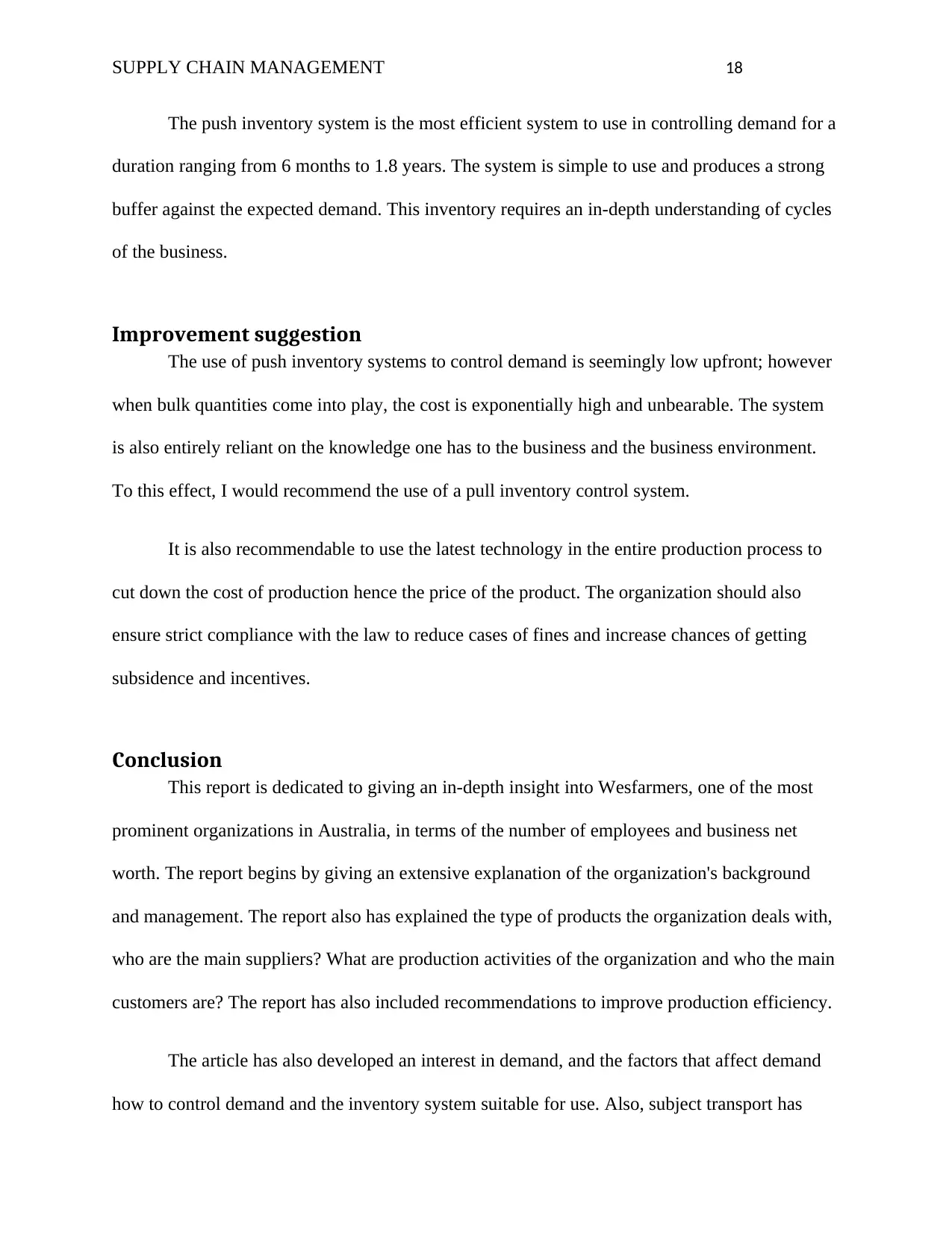
SUPPLY CHAIN MANAGEMENT 18
The push inventory system is the most efficient system to use in controlling demand for a
duration ranging from 6 months to 1.8 years. The system is simple to use and produces a strong
buffer against the expected demand. This inventory requires an in-depth understanding of cycles
of the business.
Improvement suggestion
The use of push inventory systems to control demand is seemingly low upfront; however
when bulk quantities come into play, the cost is exponentially high and unbearable. The system
is also entirely reliant on the knowledge one has to the business and the business environment.
To this effect, I would recommend the use of a pull inventory control system.
It is also recommendable to use the latest technology in the entire production process to
cut down the cost of production hence the price of the product. The organization should also
ensure strict compliance with the law to reduce cases of fines and increase chances of getting
subsidence and incentives.
Conclusion
This report is dedicated to giving an in-depth insight into Wesfarmers, one of the most
prominent organizations in Australia, in terms of the number of employees and business net
worth. The report begins by giving an extensive explanation of the organization's background
and management. The report also has explained the type of products the organization deals with,
who are the main suppliers? What are production activities of the organization and who the main
customers are? The report has also included recommendations to improve production efficiency.
The article has also developed an interest in demand, and the factors that affect demand
how to control demand and the inventory system suitable for use. Also, subject transport has
The push inventory system is the most efficient system to use in controlling demand for a
duration ranging from 6 months to 1.8 years. The system is simple to use and produces a strong
buffer against the expected demand. This inventory requires an in-depth understanding of cycles
of the business.
Improvement suggestion
The use of push inventory systems to control demand is seemingly low upfront; however
when bulk quantities come into play, the cost is exponentially high and unbearable. The system
is also entirely reliant on the knowledge one has to the business and the business environment.
To this effect, I would recommend the use of a pull inventory control system.
It is also recommendable to use the latest technology in the entire production process to
cut down the cost of production hence the price of the product. The organization should also
ensure strict compliance with the law to reduce cases of fines and increase chances of getting
subsidence and incentives.
Conclusion
This report is dedicated to giving an in-depth insight into Wesfarmers, one of the most
prominent organizations in Australia, in terms of the number of employees and business net
worth. The report begins by giving an extensive explanation of the organization's background
and management. The report also has explained the type of products the organization deals with,
who are the main suppliers? What are production activities of the organization and who the main
customers are? The report has also included recommendations to improve production efficiency.
The article has also developed an interest in demand, and the factors that affect demand
how to control demand and the inventory system suitable for use. Also, subject transport has
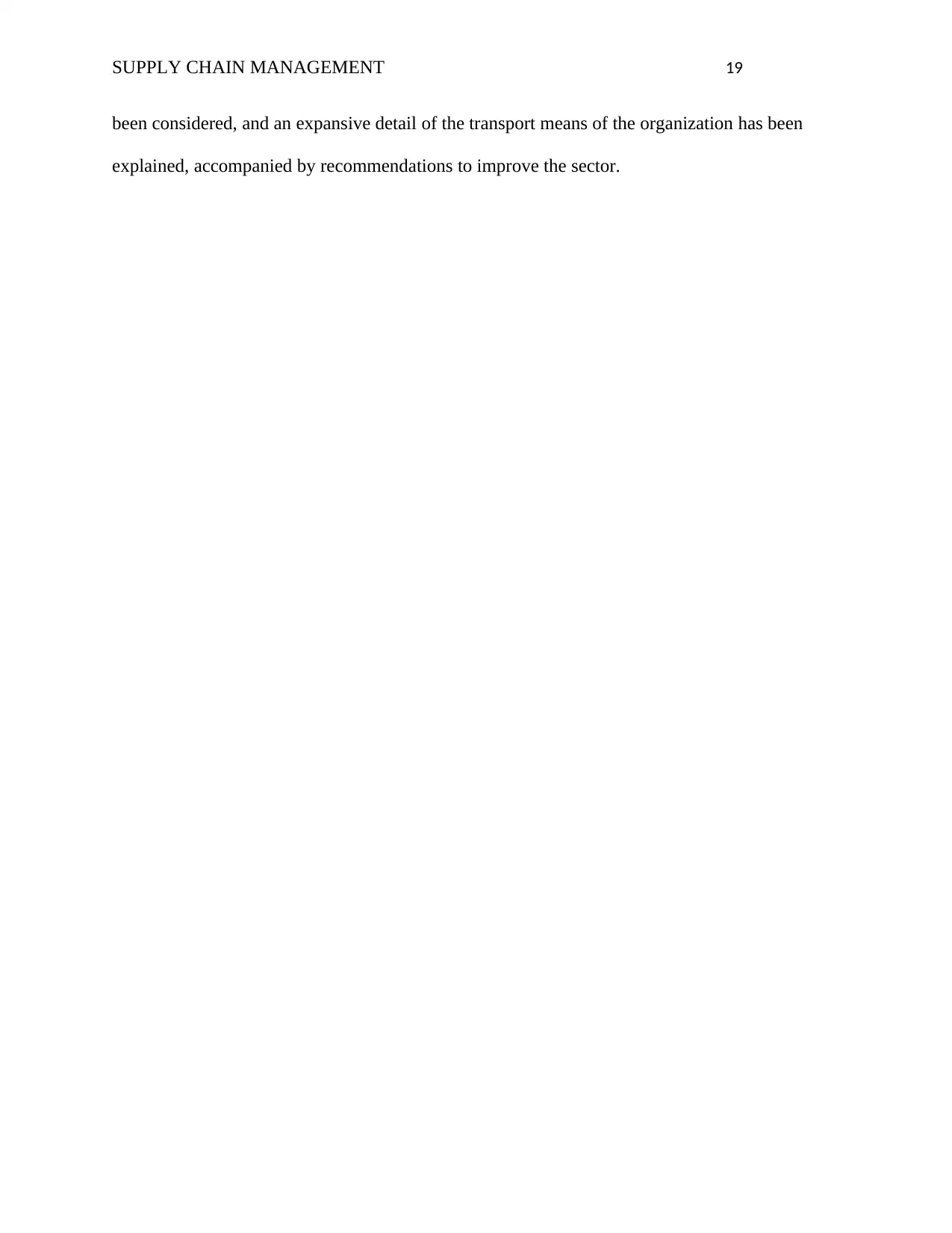
SUPPLY CHAIN MANAGEMENT 19
been considered, and an expansive detail of the transport means of the organization has been
explained, accompanied by recommendations to improve the sector.
been considered, and an expansive detail of the transport means of the organization has been
explained, accompanied by recommendations to improve the sector.
Paraphrase This Document
Need a fresh take? Get an instant paraphrase of this document with our AI Paraphraser
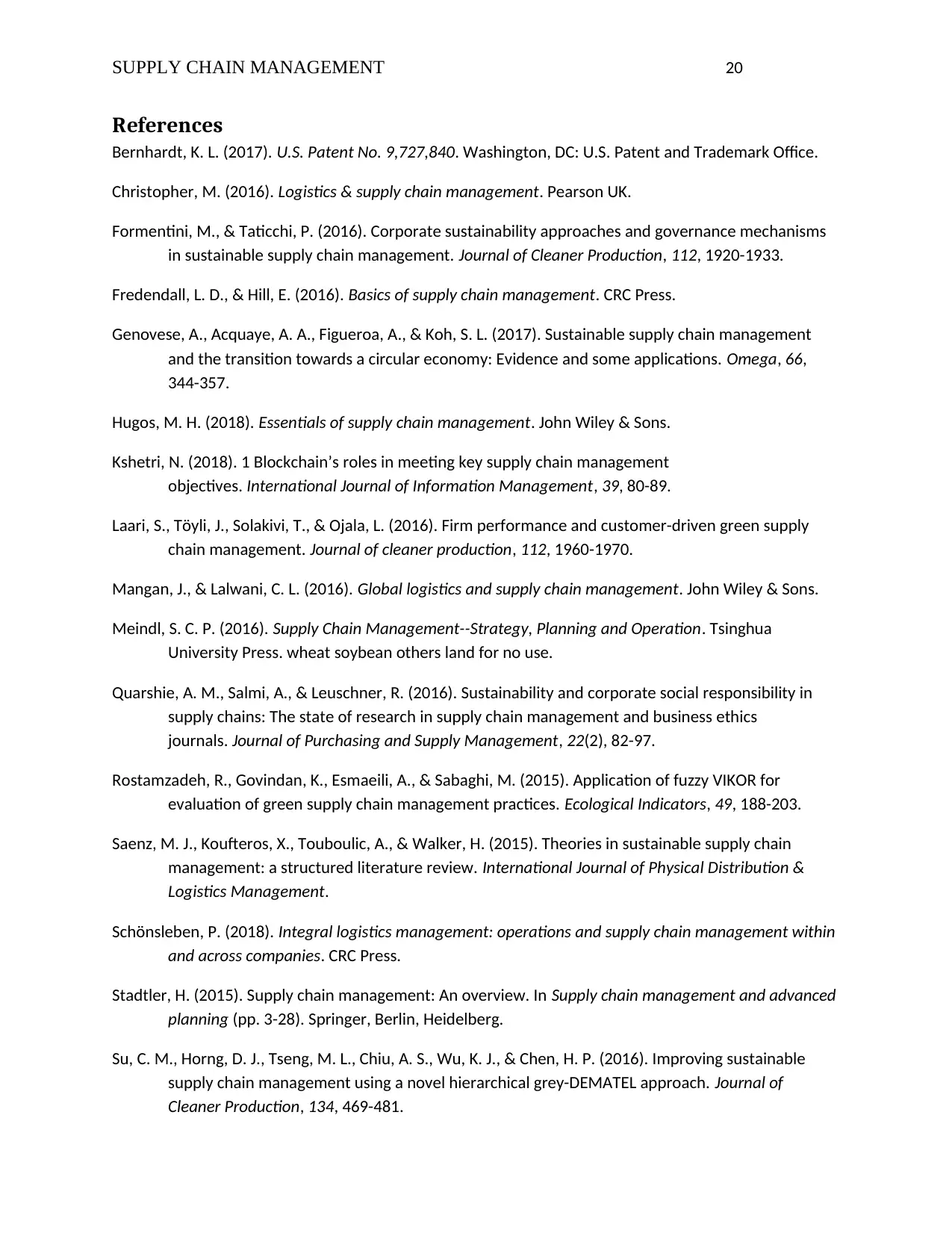
SUPPLY CHAIN MANAGEMENT 20
References
Bernhardt, K. L. (2017). U.S. Patent No. 9,727,840. Washington, DC: U.S. Patent and Trademark Office.
Christopher, M. (2016). Logistics & supply chain management. Pearson UK.
Formentini, M., & Taticchi, P. (2016). Corporate sustainability approaches and governance mechanisms
in sustainable supply chain management. Journal of Cleaner Production, 112, 1920-1933.
Fredendall, L. D., & Hill, E. (2016). Basics of supply chain management. CRC Press.
Genovese, A., Acquaye, A. A., Figueroa, A., & Koh, S. L. (2017). Sustainable supply chain management
and the transition towards a circular economy: Evidence and some applications. Omega, 66,
344-357.
Hugos, M. H. (2018). Essentials of supply chain management. John Wiley & Sons.
Kshetri, N. (2018). 1 Blockchain’s roles in meeting key supply chain management
objectives. International Journal of Information Management, 39, 80-89.
Laari, S., Töyli, J., Solakivi, T., & Ojala, L. (2016). Firm performance and customer-driven green supply
chain management. Journal of cleaner production, 112, 1960-1970.
Mangan, J., & Lalwani, C. L. (2016). Global logistics and supply chain management. John Wiley & Sons.
Meindl, S. C. P. (2016). Supply Chain Management--Strategy, Planning and Operation. Tsinghua
University Press. wheat soybean others land for no use.
Quarshie, A. M., Salmi, A., & Leuschner, R. (2016). Sustainability and corporate social responsibility in
supply chains: The state of research in supply chain management and business ethics
journals. Journal of Purchasing and Supply Management, 22(2), 82-97.
Rostamzadeh, R., Govindan, K., Esmaeili, A., & Sabaghi, M. (2015). Application of fuzzy VIKOR for
evaluation of green supply chain management practices. Ecological Indicators, 49, 188-203.
Saenz, M. J., Koufteros, X., Touboulic, A., & Walker, H. (2015). Theories in sustainable supply chain
management: a structured literature review. International Journal of Physical Distribution &
Logistics Management.
Schönsleben, P. (2018). Integral logistics management: operations and supply chain management within
and across companies. CRC Press.
Stadtler, H. (2015). Supply chain management: An overview. In Supply chain management and advanced
planning (pp. 3-28). Springer, Berlin, Heidelberg.
Su, C. M., Horng, D. J., Tseng, M. L., Chiu, A. S., Wu, K. J., & Chen, H. P. (2016). Improving sustainable
supply chain management using a novel hierarchical grey-DEMATEL approach. Journal of
Cleaner Production, 134, 469-481.
References
Bernhardt, K. L. (2017). U.S. Patent No. 9,727,840. Washington, DC: U.S. Patent and Trademark Office.
Christopher, M. (2016). Logistics & supply chain management. Pearson UK.
Formentini, M., & Taticchi, P. (2016). Corporate sustainability approaches and governance mechanisms
in sustainable supply chain management. Journal of Cleaner Production, 112, 1920-1933.
Fredendall, L. D., & Hill, E. (2016). Basics of supply chain management. CRC Press.
Genovese, A., Acquaye, A. A., Figueroa, A., & Koh, S. L. (2017). Sustainable supply chain management
and the transition towards a circular economy: Evidence and some applications. Omega, 66,
344-357.
Hugos, M. H. (2018). Essentials of supply chain management. John Wiley & Sons.
Kshetri, N. (2018). 1 Blockchain’s roles in meeting key supply chain management
objectives. International Journal of Information Management, 39, 80-89.
Laari, S., Töyli, J., Solakivi, T., & Ojala, L. (2016). Firm performance and customer-driven green supply
chain management. Journal of cleaner production, 112, 1960-1970.
Mangan, J., & Lalwani, C. L. (2016). Global logistics and supply chain management. John Wiley & Sons.
Meindl, S. C. P. (2016). Supply Chain Management--Strategy, Planning and Operation. Tsinghua
University Press. wheat soybean others land for no use.
Quarshie, A. M., Salmi, A., & Leuschner, R. (2016). Sustainability and corporate social responsibility in
supply chains: The state of research in supply chain management and business ethics
journals. Journal of Purchasing and Supply Management, 22(2), 82-97.
Rostamzadeh, R., Govindan, K., Esmaeili, A., & Sabaghi, M. (2015). Application of fuzzy VIKOR for
evaluation of green supply chain management practices. Ecological Indicators, 49, 188-203.
Saenz, M. J., Koufteros, X., Touboulic, A., & Walker, H. (2015). Theories in sustainable supply chain
management: a structured literature review. International Journal of Physical Distribution &
Logistics Management.
Schönsleben, P. (2018). Integral logistics management: operations and supply chain management within
and across companies. CRC Press.
Stadtler, H. (2015). Supply chain management: An overview. In Supply chain management and advanced
planning (pp. 3-28). Springer, Berlin, Heidelberg.
Su, C. M., Horng, D. J., Tseng, M. L., Chiu, A. S., Wu, K. J., & Chen, H. P. (2016). Improving sustainable
supply chain management using a novel hierarchical grey-DEMATEL approach. Journal of
Cleaner Production, 134, 469-481.
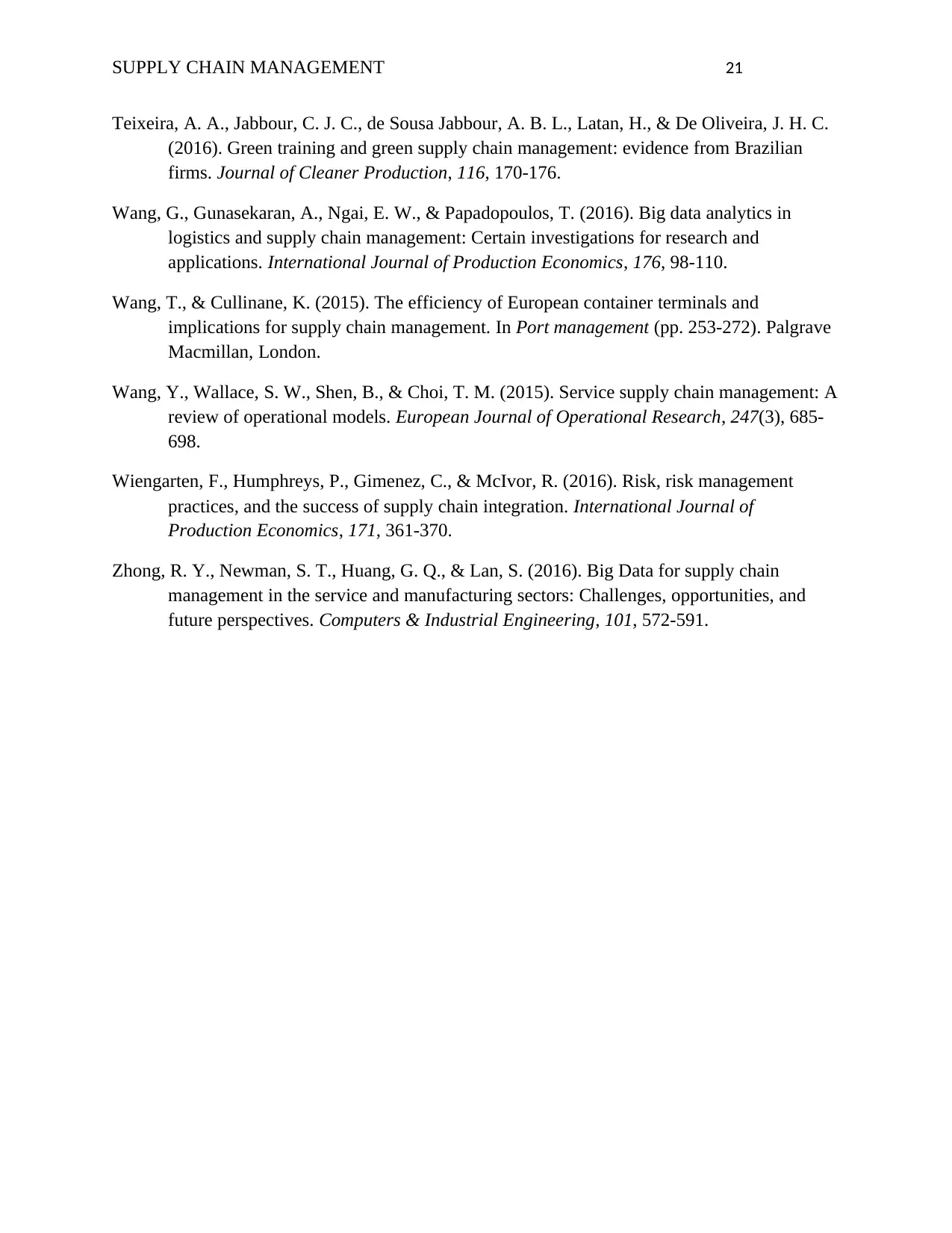
SUPPLY CHAIN MANAGEMENT 21
Teixeira, A. A., Jabbour, C. J. C., de Sousa Jabbour, A. B. L., Latan, H., & De Oliveira, J. H. C.
(2016). Green training and green supply chain management: evidence from Brazilian
firms. Journal of Cleaner Production, 116, 170-176.
Wang, G., Gunasekaran, A., Ngai, E. W., & Papadopoulos, T. (2016). Big data analytics in
logistics and supply chain management: Certain investigations for research and
applications. International Journal of Production Economics, 176, 98-110.
Wang, T., & Cullinane, K. (2015). The efficiency of European container terminals and
implications for supply chain management. In Port management (pp. 253-272). Palgrave
Macmillan, London.
Wang, Y., Wallace, S. W., Shen, B., & Choi, T. M. (2015). Service supply chain management: A
review of operational models. European Journal of Operational Research, 247(3), 685-
698.
Wiengarten, F., Humphreys, P., Gimenez, C., & McIvor, R. (2016). Risk, risk management
practices, and the success of supply chain integration. International Journal of
Production Economics, 171, 361-370.
Zhong, R. Y., Newman, S. T., Huang, G. Q., & Lan, S. (2016). Big Data for supply chain
management in the service and manufacturing sectors: Challenges, opportunities, and
future perspectives. Computers & Industrial Engineering, 101, 572-591.
Teixeira, A. A., Jabbour, C. J. C., de Sousa Jabbour, A. B. L., Latan, H., & De Oliveira, J. H. C.
(2016). Green training and green supply chain management: evidence from Brazilian
firms. Journal of Cleaner Production, 116, 170-176.
Wang, G., Gunasekaran, A., Ngai, E. W., & Papadopoulos, T. (2016). Big data analytics in
logistics and supply chain management: Certain investigations for research and
applications. International Journal of Production Economics, 176, 98-110.
Wang, T., & Cullinane, K. (2015). The efficiency of European container terminals and
implications for supply chain management. In Port management (pp. 253-272). Palgrave
Macmillan, London.
Wang, Y., Wallace, S. W., Shen, B., & Choi, T. M. (2015). Service supply chain management: A
review of operational models. European Journal of Operational Research, 247(3), 685-
698.
Wiengarten, F., Humphreys, P., Gimenez, C., & McIvor, R. (2016). Risk, risk management
practices, and the success of supply chain integration. International Journal of
Production Economics, 171, 361-370.
Zhong, R. Y., Newman, S. T., Huang, G. Q., & Lan, S. (2016). Big Data for supply chain
management in the service and manufacturing sectors: Challenges, opportunities, and
future perspectives. Computers & Industrial Engineering, 101, 572-591.
1 out of 21
Related Documents
Your All-in-One AI-Powered Toolkit for Academic Success.
+13062052269
info@desklib.com
Available 24*7 on WhatsApp / Email
![[object Object]](/_next/static/media/star-bottom.7253800d.svg)
Unlock your academic potential
© 2024 | Zucol Services PVT LTD | All rights reserved.



